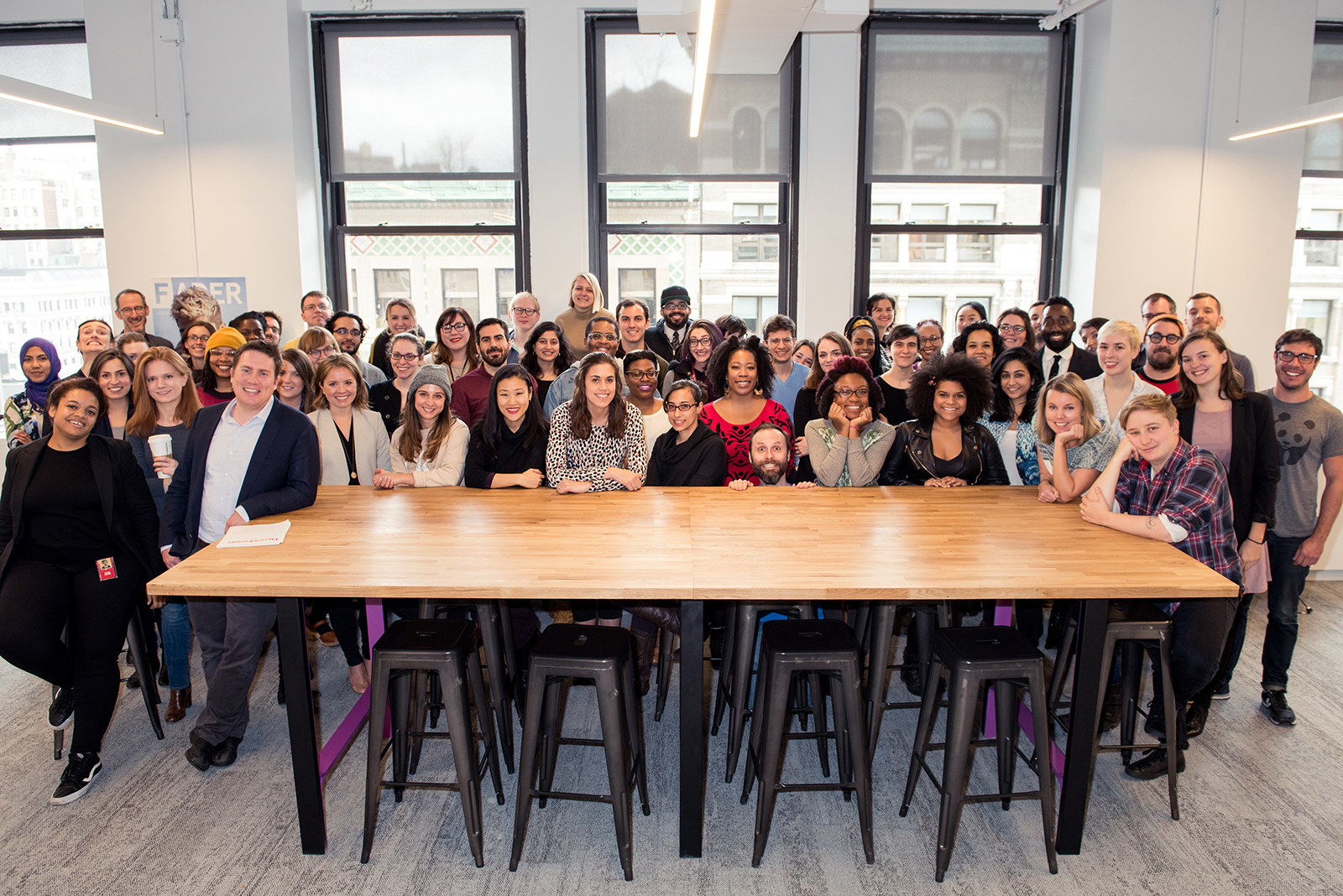BuzzFeed launched a news section in 2012. It hired a ton of people, opened international offices, produced podcasts and shows, formed a union, won a Pulitzer Prize. Then it shuttered international offices, laid people off, and on Friday, May 5, shut down for good and archived its website.
Hundreds of people worked here over the years and made this place what it was — this oral history is an incomplete account of what made this place both extraordinary and exasperating. There are so many stories and people missing, either because it got too long, we ran out of time, or we had to delete some of the really juicy stuff. (Testimonials have been edited for length and clarity.)
If your interest is an analysis of the business forces that led to this moment, there are plenty of thorough and smart assessments (our former editor-in-chief just wrote a whole book, awkwardly released the same week we were told we needed to close, about how digital media was doomed.) We wanted to make this oral history so that the final word on BuzzFeed News (literally, the last thing to be published on our site) would come from the people who worked here.
If you’re reading this, or have read our stories before, thank you. If you watched our shows, listened to our podcasts, clicked on our push alerts and tweets, or scrolled past our headlines on your phone, we want to sincerely thank you for supporting us, sharing our work, and helping us survive (and even thrive!) in a chaotic media landscape as long as we did.
— Katie Notopoulos
“Tell people you’re with BuzzFeed the same way you would tell them you’re with the New York Times.”
McKay Coppins, former politics reporter: In the beginning, “BuzzFeed News” was basically Ben Smith, Rosie Gray, Zeke Miller, Andrew Kaczynski, and me covering the 2012 Republican presidential primaries. Ben’s instructions to us were basically: Don’t waste time doing the same stories everyone is doing. Break news, get scoops, make trouble. I remember at the first Republican presidential debate in early 2012, Ben named our portable Wi-Fi thing “BUZZFEED SURVEILLANCE DRONE” so that the other outlets would see it on their laptops and get freaked out.
Doree Shafrir, former executive editor: Ben Smith sent me a DM on Twitter and asked if I wanted to meet with him — it was before he had actually started but his hiring had been announced. I remember the process going fairly quickly — I met with Jonah Peretti and Ken Lerer, and then it was done. Those first few months of 2012 were bananas. I started in February — I think I was employee No. 65 — and we were hiring multiple people per week. The mandate was to grow grow grow. There was no real sense from Ben about what it took to launch or maintain multiple lifestyle and entertainment verticals — like we should just launch a sports vertical, covering national sports, with two or three people.
Katie Notopoulos, senior tech reporter: I was hired in early 2012 to do the viral list stuff. Michael Hastings, who was a big-time actual journalist, sat next to me. He’d be on the phone like, screaming at Reince Priebus and I’d be looking at a Tumblr of Sonic the Hedgehog erotica. We got along great. One time I had to actually call someone for a post, and Ben Smith said to me, “Look at you, you’re doing reporting!” I was disgusted.
At the time, “news” was just a handful of verticals: politics, tech, sports, “women’s interest.” It was fluid between the viral and news people. We had a big weekly meeting where we’d dissect the top-performing posts and why they worked. There was a giant TV screen that showed the leaderboard of who had the most traffic. Around 2014, there was an official segmenting of “News” from “Buzz” (viral lists and quizzes) and “Life” (food, fashion DIY). At some point in a reorg that seemed, from the plebes within, to be a result of some sort of nightmare Mothra vs. Godzilla fight, Buzz and Life were moved under Ze Frank, who ran video, and Ben Smith was in charge of just news.
Ben Smith, former editor-in-chief: I was always ambivalent about splitting News. It felt culturally inevitable after the political and social climate changed, but it played to journalists’ worst, snobbish instincts in some ways. We worked for BuzzFeed, after all, and it pulled News toward feeling like a charity. It seemed necessary at the time — in the Trump era, News was too dark to be next to the BuzzFeed Brand — but I had some worries.
Rosie Gray, former politics reporter: The first time I set foot in the BuzzFeed office was December 2011 for a meeting with Ben and the other three reporters he’d hired to cover the 2012 election. Ben said to us something to the effect of “Tell people you’re with BuzzFeed the same way you would tell them you’re with the New York Times.” I officially started a couple weeks later. I drove Ben back to New York after the New Hampshire primary, and he spent half the drive on his computer writing a story. We talked about whether I was going to finish college, and we both halfheartedly said that I really should, and I think we both knew it wasn’t going to happen.
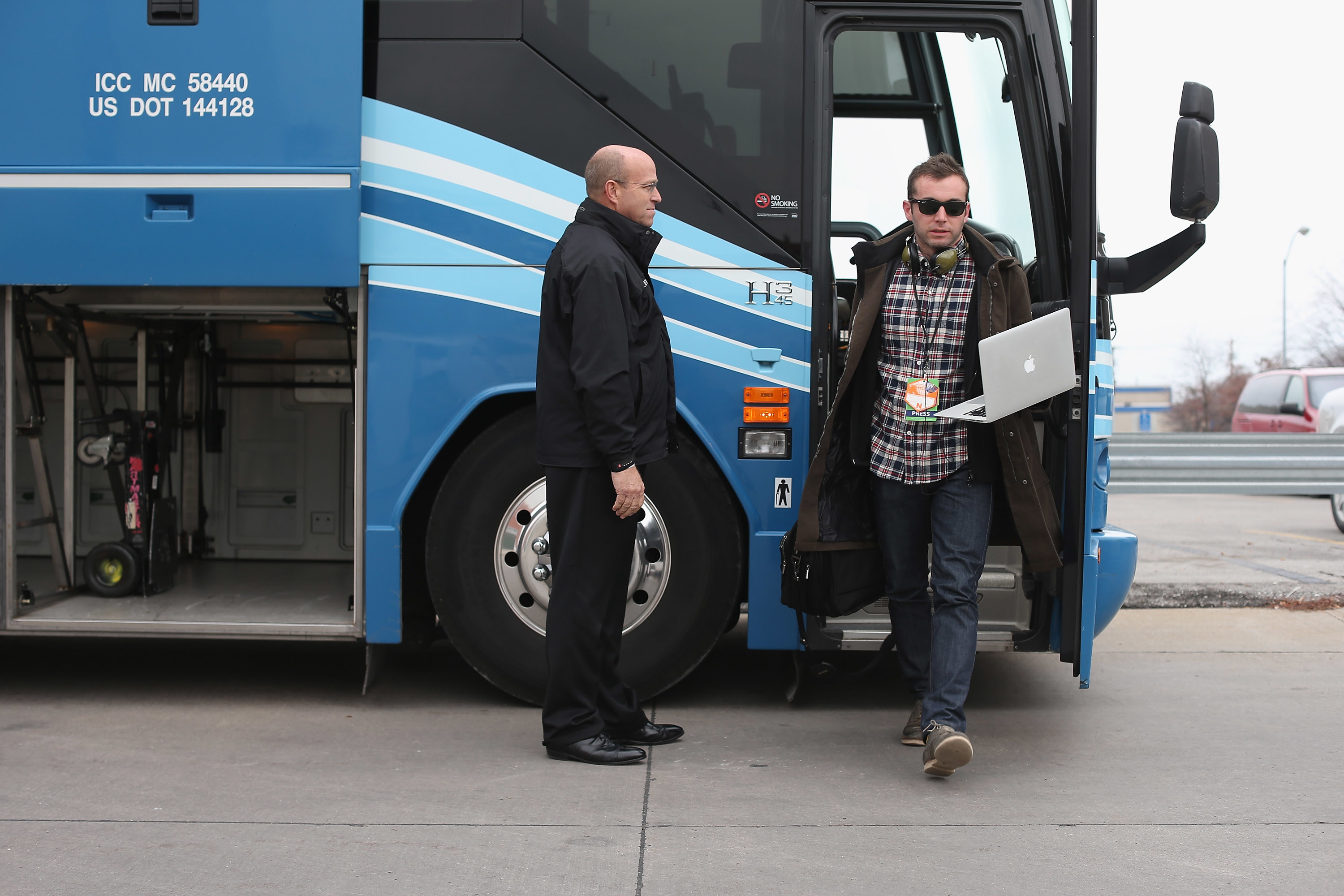
Brandon Wall, director of newsroom strategy and experiments: I fell in love with BuzzFeed back during the 2012 election. I consumed anything and everything Michael Hastings, Ruby Cramer, and McKay Coppins wrote. When BuzzFeed hired Andrew Kaczynski, I decided there was nowhere else I wanted to work. Andrew had built a name for himself by aggressively digging up old C-SPAN clips of Republican primary candidates. I decided that if there is a place out there weird enough to hire the Old C-SPAN Clips Guy, they might be weird enough to hire me.
John Herrman, former tech editor: I remember the office in 2012 with white walls and red pipes. Good view. When it rained our internet was bad, because it was being beamed from the Empire State Building. Three grinning visages haunted the room. Jonah Peretti. Ben Smith. Jon Steinberg. Your goal was to avoid eye contact with them. One way I can describe Ben and Jonah, who are otherwise fairly different people, is as guys who seem like they’d never make eye contact who instead make it all the time.
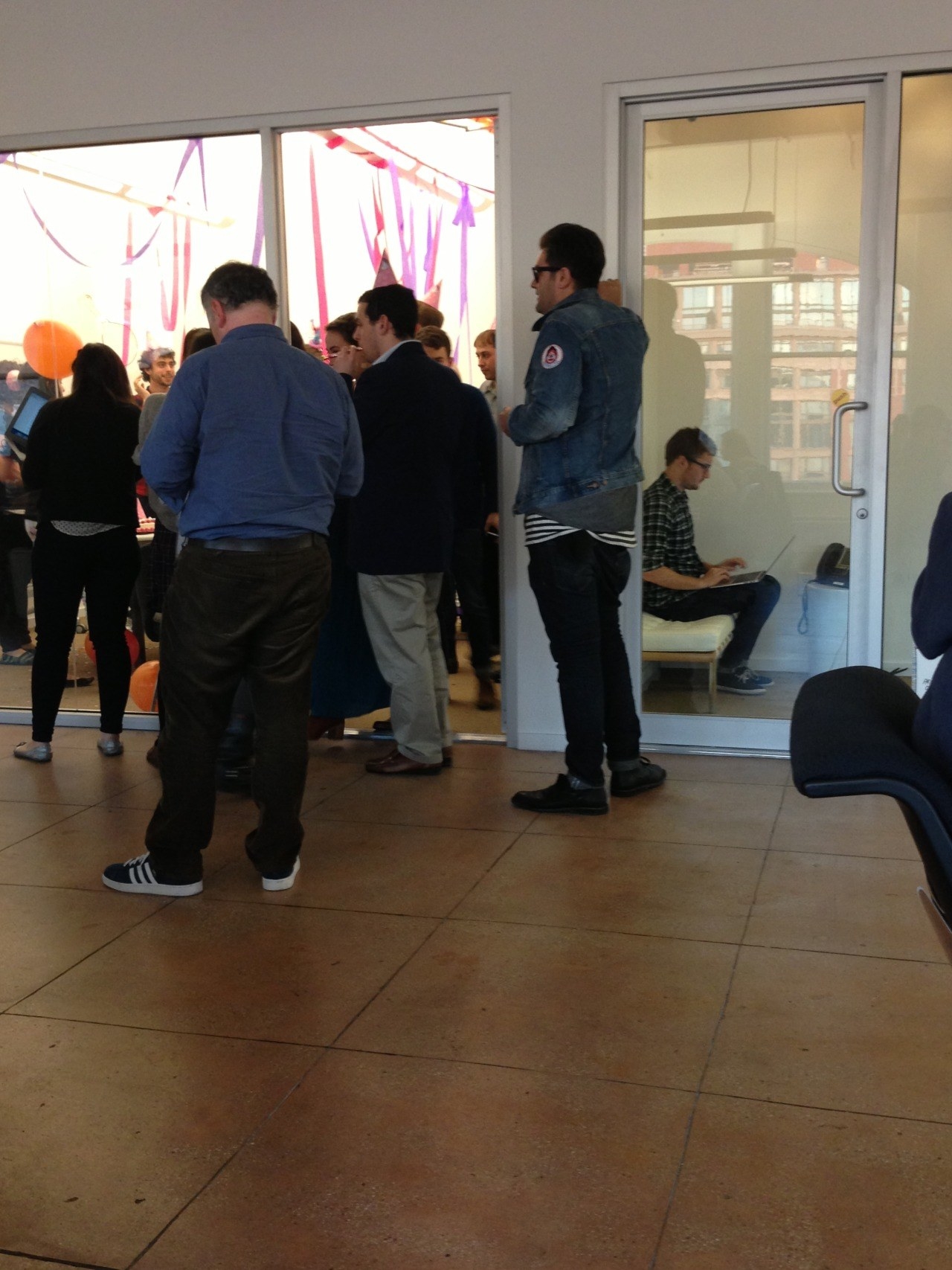
Ellie Hall, senior reporter: I was the first person to be hired for the newly formed “News” team in 2013. The first big test of our operation was the Boston Marathon bombings, and those long days made it clear to all of us that we needed an adult in the room. Enter Lisa Tozzi. She came to the office before she was officially hired for a sort of “meet your possible boss” group lunch/interview, and we were all blown away. We all swarmed Ben and essentially demanded that he hire her as news director. We all looked up to her — literally, because she was one of the first people in the entire office to use a standing desk.
Ben Smith, former editor-in-chief: I hired Lisa Tozzi to run the breaking news team. I remember how impressed I was by Lisa — but then how massively impressed everyone was to have someone descend from the heights of the New York Times to join us, and then being a little annoyed by that because why should everyone be so worshipful of the Times!
Lisa Tozzi, former news director: I was in Ben’s office or something at the old District 9, crowded, vermin-infested 21st Street office. Some Anthony Weiner stuff was happening, and Ellie Hall came running over and slapped this on the glass. (We blurred, I believe.)
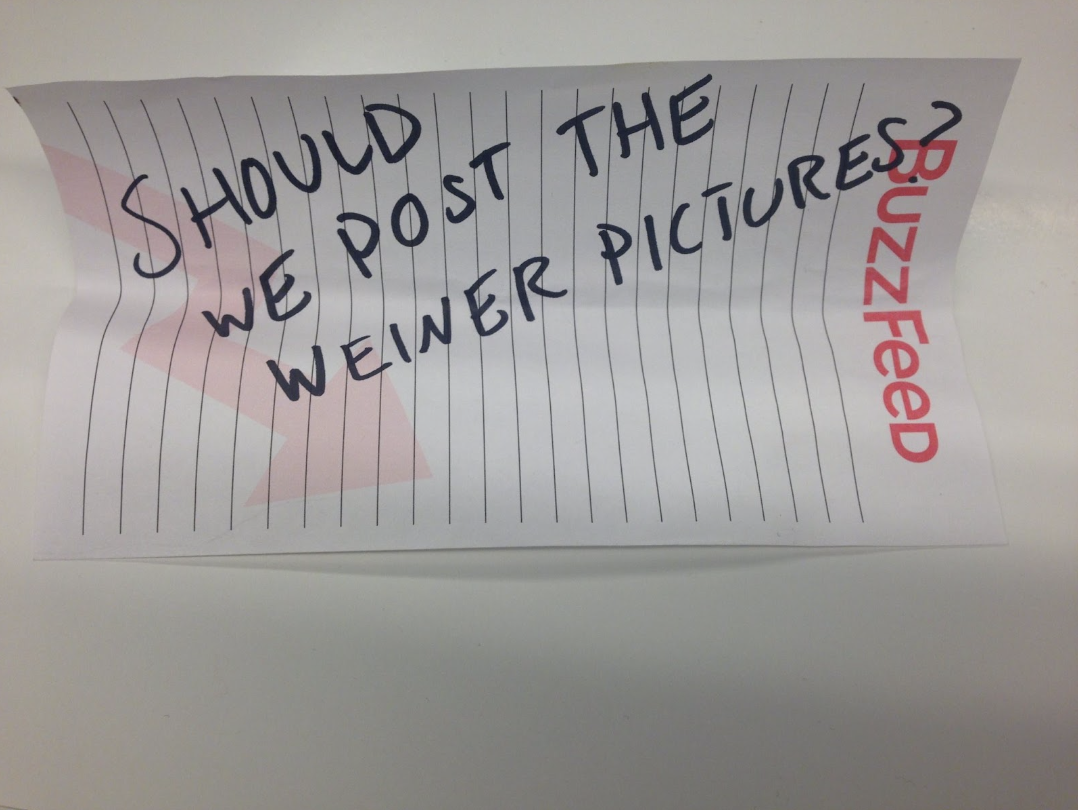
Zoe Tillman, former politics reporter: The day I interviewed in the New York office it was Ben Smith’s birthday. There were pieces of paper with a close-up photo of Ben’s face taped up all over the walls as I entered the building. When I got to the newsroom, everyone in the room was wearing a T-shirt with the picture of Ben. His face was everywhere.
Tom Namako, former news director: I used to literally turn on the lights and unlock the doors at the office above Home Depot at 5:55 a.m. and would find McKay sometimes sitting with Diet Coke cans around him, just agonizing over his computer, on the floor. He’d scare the shit out of me.
McKay Coppins, former politics reporter: There was a stretch where I was staying late at the office writing several nights a week and there was this one coworker I didn’t really know who would show up after midnight and sort of nod at me from a distance and then just...stay. Somewhere in the office. I’m pretty sure she was living there, but I didn’t know for sure.
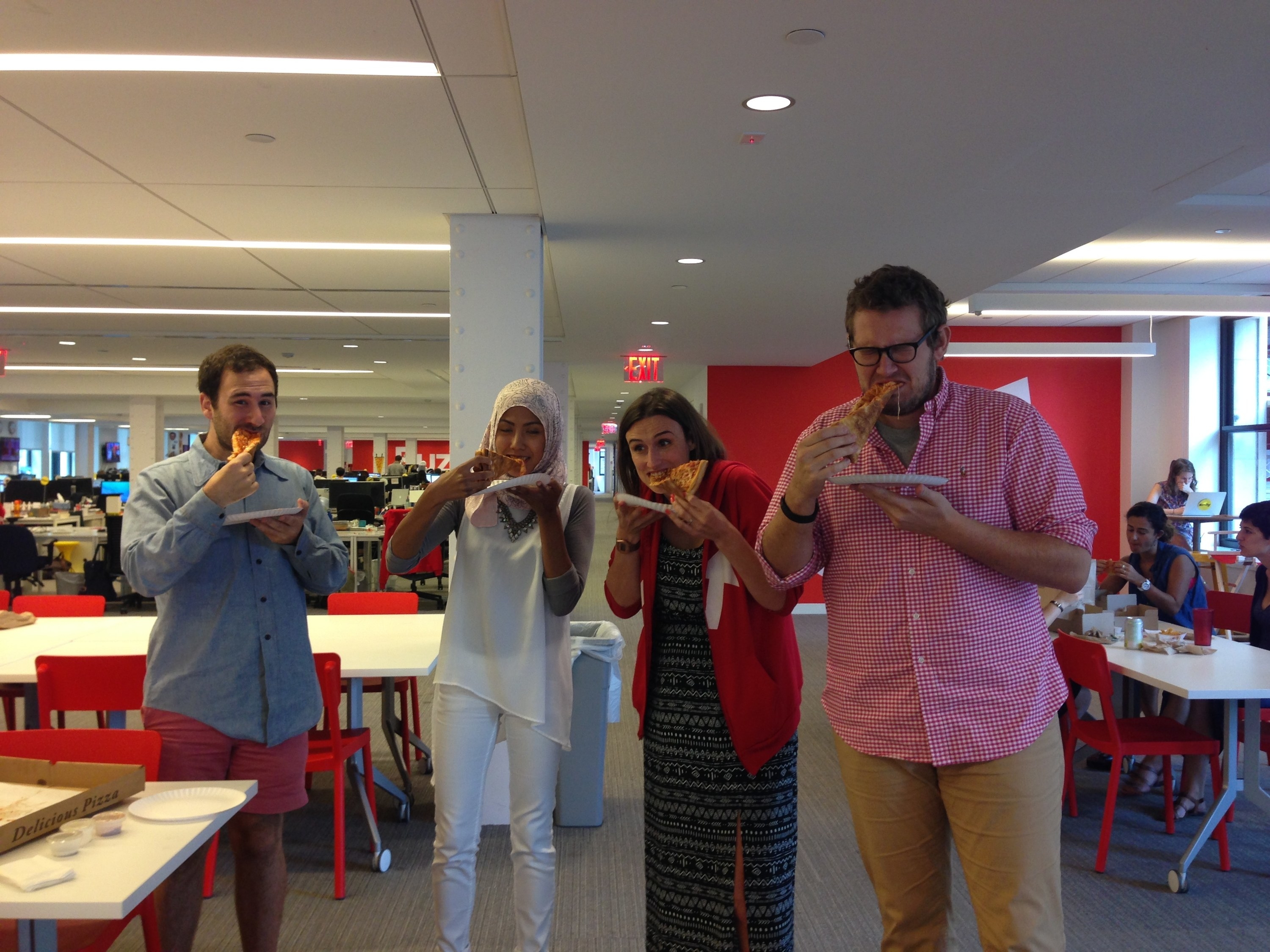
Tom Warren, investigative reporter: The first time I visited the New York office, I stepped over the threshold only to be greeted by a man on a hoverboard holding a tray of sex toys, some of which were frankly quite terrifying. He registered my surprise, then cackled and sped off down the corridor. I never found out why he was doing that or whether HR should have gotten involved.
Albert Samaha, senior culture reporter: I’d come from the Village Voice, and other local papers before that, and every place I’d worked was facing existential crisis. Then suddenly, Adam Serwer recruits me onto BuzzFeed’s National desk, and there’s free lunch and tons of happy-looking people hopping around. It felt like a fantasy — excess and money and bright colors and whimsically shaped chairs all around. I couldn’t believe such a place existed in the journalism industry. I remember my first BuzzFeed Christmas party, in 2014, walking into this fancy club space, in lower Manhattan, dim lights, lots of dancing. And, there, up on a stage: acrobats and fire dancers. I remember thinking, like, Damn, either we’re saved or we’re doomed.
Joel Anderson, former sports and national reporter: On my first day, an email went out to the office: Kanye West was coming in for a visit with Jonah. When I got down to their floor, Kanye was sitting in a tight office, wildly gesticulating while Jonah sat there impassively. I snuck a picture and then tweeted it out. A few minutes later, another email went out: We shouldn’t gather around Jonah’s office, and we definitely shouldn’t be posting pictures about the visit. Heh, it was too late. I didn’t delete the tweet, and I’ve still got the picture.

Dan Vergano, former science reporter: I started work in February on a cold Tuesday morning [in the DC office], and waited. Then this big dude came shambling up to the door I had been buzzing to get into for 10 minutes, lit a cigarette, and asked me if I was Dan. It was John Stanton, who I quickly figured out was actually a friend of a bouncer friend of my wife’s from my misspent youth in DC. My new colleagues all struck me as twentysomething strivers, but with perpetual hangovers. It took me about a week to figure out everyone was reporting and writing their pieces on their phone.
Venessa Wong, senior culture reporter: My first job here in 2015 was to report on food companies. I did a really simple post about McDonald’s selling mozzarella sticks for $1, just something short and fun that I put very little time into, and suddenly half a million people had read that story. It was a level of reach I had never experienced before, and it was absolutely thrilling and terrifying. There was a clear sense that if something was being said online, people were hearing it from BuzzFeed.
Hayes Brown, former deputy world news editor: It was an absolute dream of a gig to work under World desk editor Miriam Elder and in the pirate ship that DC Bureau Chief John Stanton was running. I was so proud (and to be frank, a little smug) when I’d tell people all the cities where we had correspondents based, which over the years included Mexico City, Istanbul, Nairobi, Dakar, Beijing, Hong Kong, New Delhi, and Moscow.
Tom Warren, investigative reporter: Despite the warnings of more experienced journalists that I would be mad to work at BuzzFeed, I applied as soon as they opened an investigations unit. All we wanted to do was blow the fucking doors off…and guess what happens when you give a group of twentysomethings unlimited resources to chase stories? They go batshit crazy. Absolutely fucking bananas.
We flew round the world chasing tips, conducted surveillance ops on money launderers, took sources out for mindblowingly expensive meals in the hope of getting leaked documents, rode through rainforests on the back of motorbikes, and engaged in a host of other wild adventures, not all of which are fit to print. There were wild parties, lots of them. One week you would be at a warehouse rave in Brooklyn, and two weeks later you would be flying into Istanbul for security training and heading for a night out with whichever members of the press corps were in town. We had the wind at our backs and had a beast of a fucking time. It was majestic.
Albert Samaha, senior culture reporter: I think one reason the vibes were always so positive, and the place never felt internally competitive the way some other newsrooms do, is that we had this collective mindset of abundance. To put it crudely, we were all trying to build our newsroom’s credibility, so every colleague's success helped elevate your own reputation. For a while, the newsroom would echo with the same script: Hi, my name is so-and-so, I’m a reporter with BuzzFeed News, and I’m working on a... BuzzFeed... B-U-Z-Z-F-E-E-D... it’s a digital news outlet..." That was like the soundtrack of those early days. It became a running joke. But then eventually, maybe by early 2016, we didn't have to spell it out anymore.
Karolina Waclawiak, editor-in-chief: I had been at the Believer Magazine (which had literally no budget for anything) and Saeed Jones called me and said he wanted me to join and start a literary magazine within BuzzFeed News with him. Then the Pulse nightclub shooting happened, and suddenly I was swept into the news cycle. Ben Smith told me culture touched everything so I had to find a way to cover…everything. Soon after, I was sending reporters to Trump rallies and all over the country covering news. When I first started, I asked what our budget was for the Culture desk and was told, “Don’t ask or you might get one,” from someone who worked in Finance. When I saw what editors were paying for stories on other desks I was in absolute shock. I knew it couldn’t last.
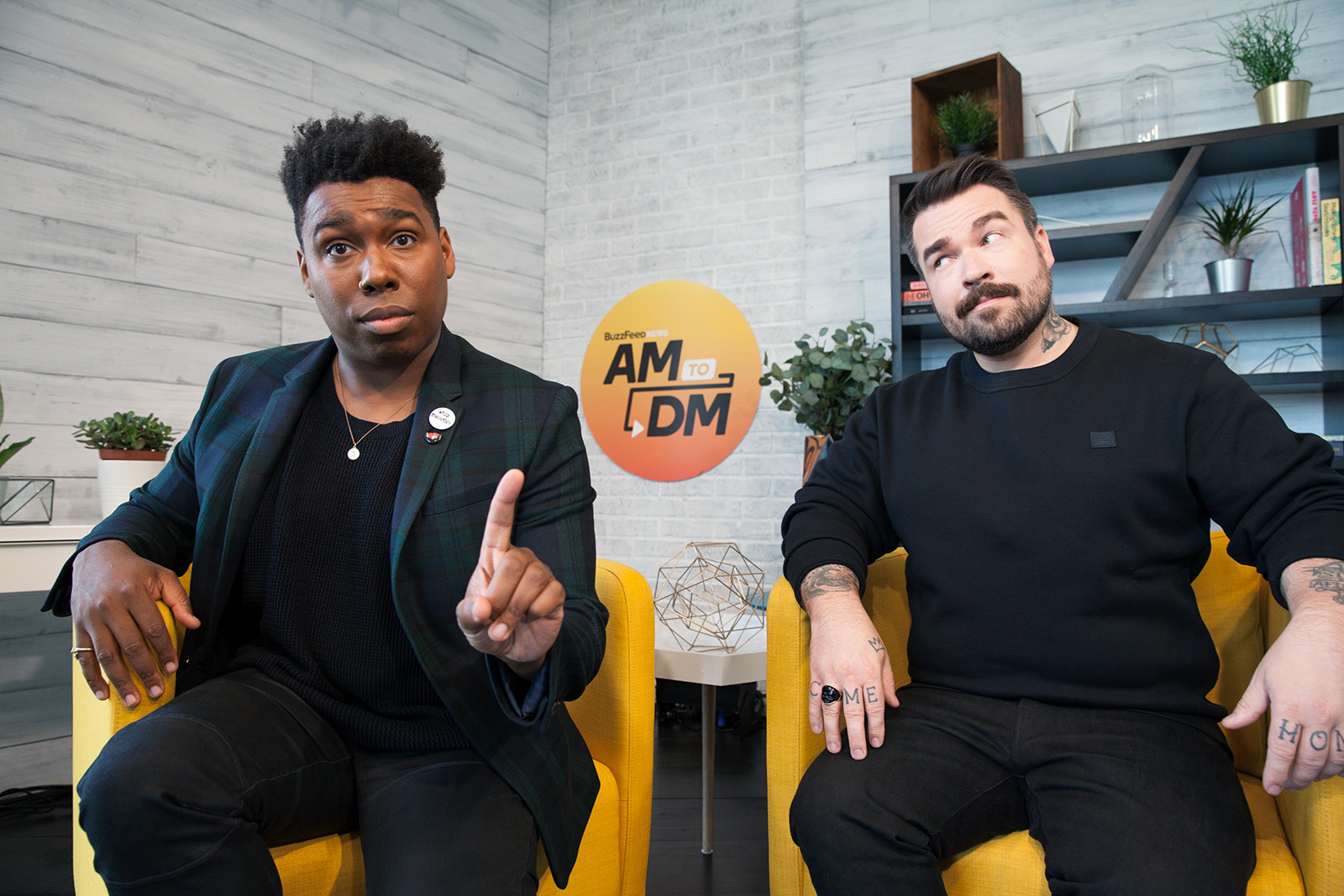
“I like to imagine Elon Musk’s face if he ever finds out that Twitter paid to run a BuzzFeed News morning show.”
Doree Shafrir, former executive editor: There was so much organizational-slash-strategy whiplash. Like they would launch projects and it would be the hot new thing for like six months and then they would be like, Actually, never mind. The relationship between News and main BuzzFeed, and then with video, was insane. Like, no one was in charge.
Brandon Hardin, curation editor: For a while it felt like the only money you could depend on was from social media platforms for shows. AM2DM was funded by Twitter, sort of a morning talk show. Facebook gave us money for Profile, hosted by Audie Cornish, when they still had the laughable idea people were going to watch longform journalism on Facebook. Other shows, including a game show, were spun up, wound down, and forgotten about.
We had a podcast for a bit you could summon on Alexa. In theory. Because it turned out calling a podcast “The News By BuzzFeed News” made it basically impossible to call up, as Alexa stopped listening after the first “news.”
Julia Moser, former AM2DM producer: The pitch for AM2DM was essentially “the Today show/Good Morning America but our anchors are allowed to say ‘fuck’ and wear jeans.” Our original motto was “All the news too lit to print” and then the New York Times sent us a cease and desist I believe? There was one week where I produced a segment about MS-13 with John Stanton and also was trying to book Bruno, a very fat cat who’d gone viral on Twitter, which to me was BuzzFeed News and AM2DM in a nutshell.
Zach Ares, senior motion designer and drag queen: For one of their first promos, AM2DM made a video called “Tucker Carlson looks at his guests like they’re eating mayo straight out of the jar”... and then Jesse McLaren, and hosts Saeed Jones and Isaac Fitzgerald, ate a full jar of mayo on camera. [Editor’s note: Saeed and Isaac actually ate vanilla pudding. Still gross.]
Katie Notopoulos, senior tech reporter: I like to imagine Elon Musk’s face if he ever finds out that Twitter paid to run a BuzzFeed News morning show. That’s worth it all.
Veronica Dulin, DC office manager/editorial assistant: I was the office manager and had to escort all the AM2DM guests up to the top floor. One day, the guest was the attorney general of Texas, who was accompanied by an armed security team. During the interview, a guy sidled up to me and said, “Hey, we can’t find our friend Chris. I think he’s trapped somewhere.” The elevator in the DC office was always breaking down, and I feared the worst. We found him trapped on the fifth floor, and we had to yank the doors of the broken elevator open to get him out. I spent the whole time bonding with this man to try and get him to not tell mean stories about how the liberal news outlet trapped him. After the interview, Zoe Tillman, who had interviewed the AG, came up to me and asked which guy got caught. I told her and she said, “Oh my god, that’s Chris SCALIA.” I trapped the son of a Supreme Court justice in the elevator.
David Mack, senior reporter: I was one of the fill-in hosts for AM2DM, which meant I got to interview a ton of big name stars on camera. Producers would also try to ensure I got to interview every famous Aussie that came through, including Guy Pearce, Jacki Weaver, and Toni Collette. The viewership of the show would mostly depend on whether Twitter boosted it on the platform, which was worrying from the start. I also helped host shows we briefly had on Facebook (Profile) and Snapchat (BTW). All of these received money from the platforms, which of course was not going to last forever. But that’s just how it was. I was hired to write and edit, and all of a sudden I was hosting TV. It felt like we were really booming into a full media division.
I trace it back to when homepage editor Gavon Laessig did a Facebook Live on Super Tuesday for the 2016 election and we got a ton of views by doing stunts like making him take shots when a different race was called. He got smashed, but it was fun! And then suddenly we were in the live news business.
Tom Namako, former news director: Gavon Laessig’s Facebook Live election show needs an oral history of its own. He threw up on the floor of politics editor Katherine Miller’s office, and she never went back in again because of the smell. We basically held him hostage in there for eight hours feeding him only bourbon and, I think, ice cream.
Gavon Laessig, former breaking news editor: The pitch for this Facebook Live show was “Watch As Super Tuesday Ruins This Man’s Night One State At A Time.” I would do drinking games while I interviewed politics editors and reporters, all while providing real-time updates to the 2016 presidential primaries. A microphone, several bottles of liquor, and a tub of peanut butter were placed in front of me. At one point I put Mentos in my mouth and swigged Diet Coke, simply destroying the carpet with a geyser of foam spraying out of my mouth. I think I did this for four or five hours before Lisa Tozzi and Shani Hilton, legitimately concerned for my health, pulled the plug. They kept feeding me seltzer so I’d have something besides ice cream and Southern Comfort in my stomach. Shockingly, I don’t remember many of the details.
Brandon Wall, director of newsroom strategy and experiments: Being in the LA office, a lot of our shows felt like “a New York thing” that I didn’t have any connection with beyond waking up to some amazing content every morning, but there were eventually some that were more anchored with LA: Hella Opinions was an amazing talk show on Wednesday nights, and there was also a short-lived HQ Trivia knockoff called Outside Your Bubble. There was a period of time in my life where I had to help oversee a nightly game show in the Facebook app?
Emerson Malone, copy editor: We had a short-lived experimental video animated series on Spotify, of all places. It was something that required animators and graphic designers, and it would come down to West Coast copy editors to look at it late at night. The video would go live in the morning, but by then it would be yesterday’s news if not news from two days previous. And it was a video… that lived somewhere… on Spotify.
Julia Furlan, former head of audio: From what I can tell, some bigwig at Spotify approached Ben and said, “We want to experiment with video,” and Ben was like, “OK sure, why don’t we make a video podcast?” But it would have been way too complicated to do longform video podcasts and Spotify didn’t want that. So we decided to adapt our daily podcast into video. In order to do that, Spotify needed us to upload our video every day by 4 a.m. And thanks to Dennis Huynh, the amazing design director and a team of animators who worked overnight in India, we managed to figure it out. And then Spotify just like….didn’t upload it. Like, every day we were doing this absurd task and Spotify’s team could not figure out how to play it in their app.
Emerson Malone: Copy also looked at each episode of the Netflix show Follow This, which was sometimes wild, because in one of Scaachi’s episodes I literally had to ask:
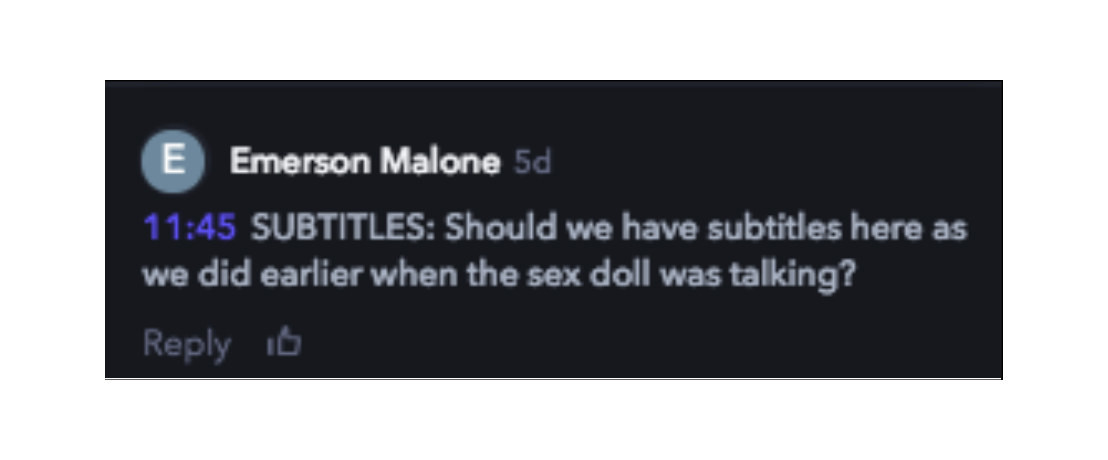
Scaachi Koul, senior culture writer: That sex doll episode still haunts me. We went to the house of a guy who owned four dolls, and he had them hanging by their necks on the wall. One of our camera guys had to help move one, and he lifted the doll to repose her (these things are like 120 pounds of dead weight), and after he did it, he had two huge boob-sized prints on his shirt. It turns out you have to dust the sex dolls with cornstarch so that the skin feels like skin and doesn’t get sticky.
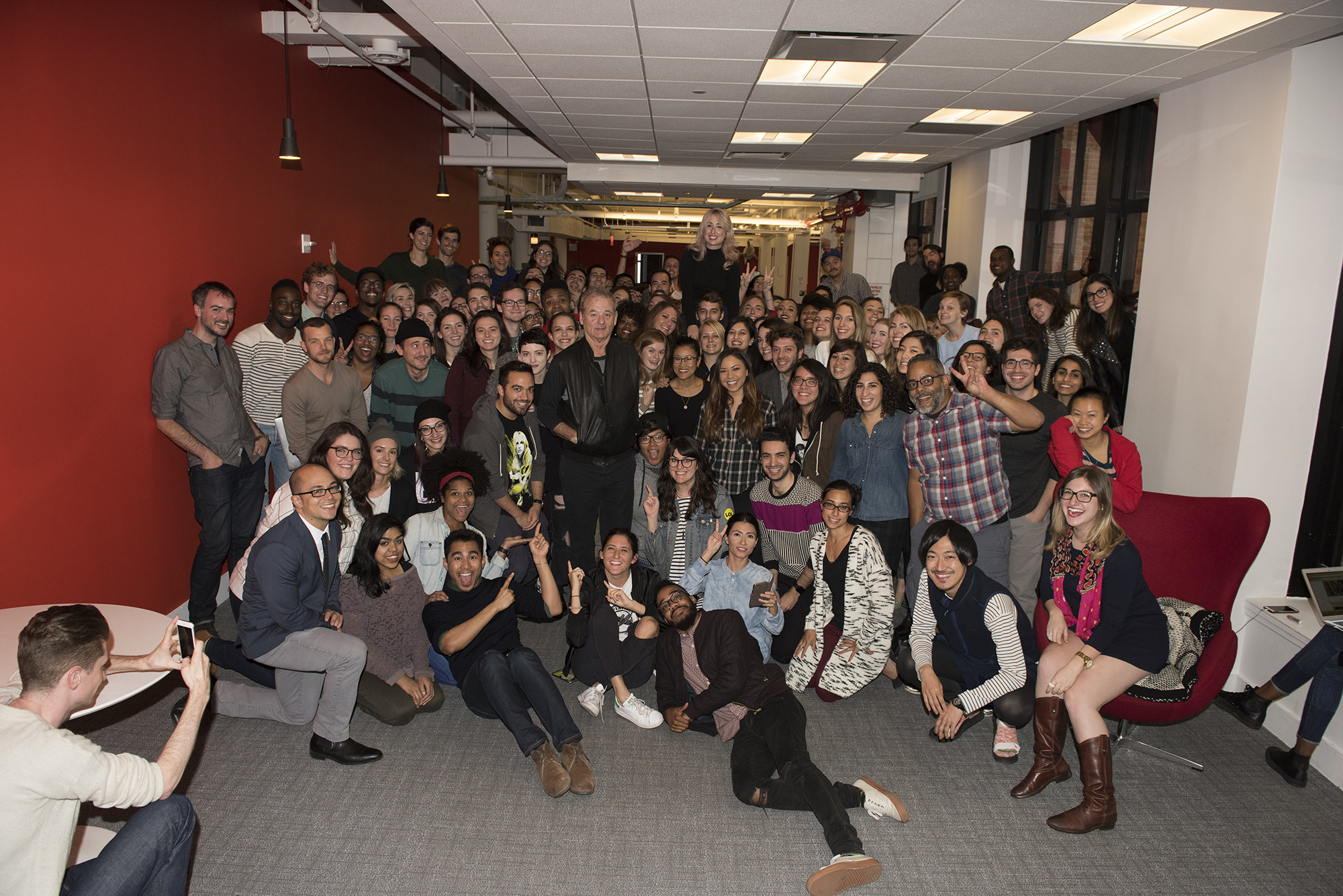
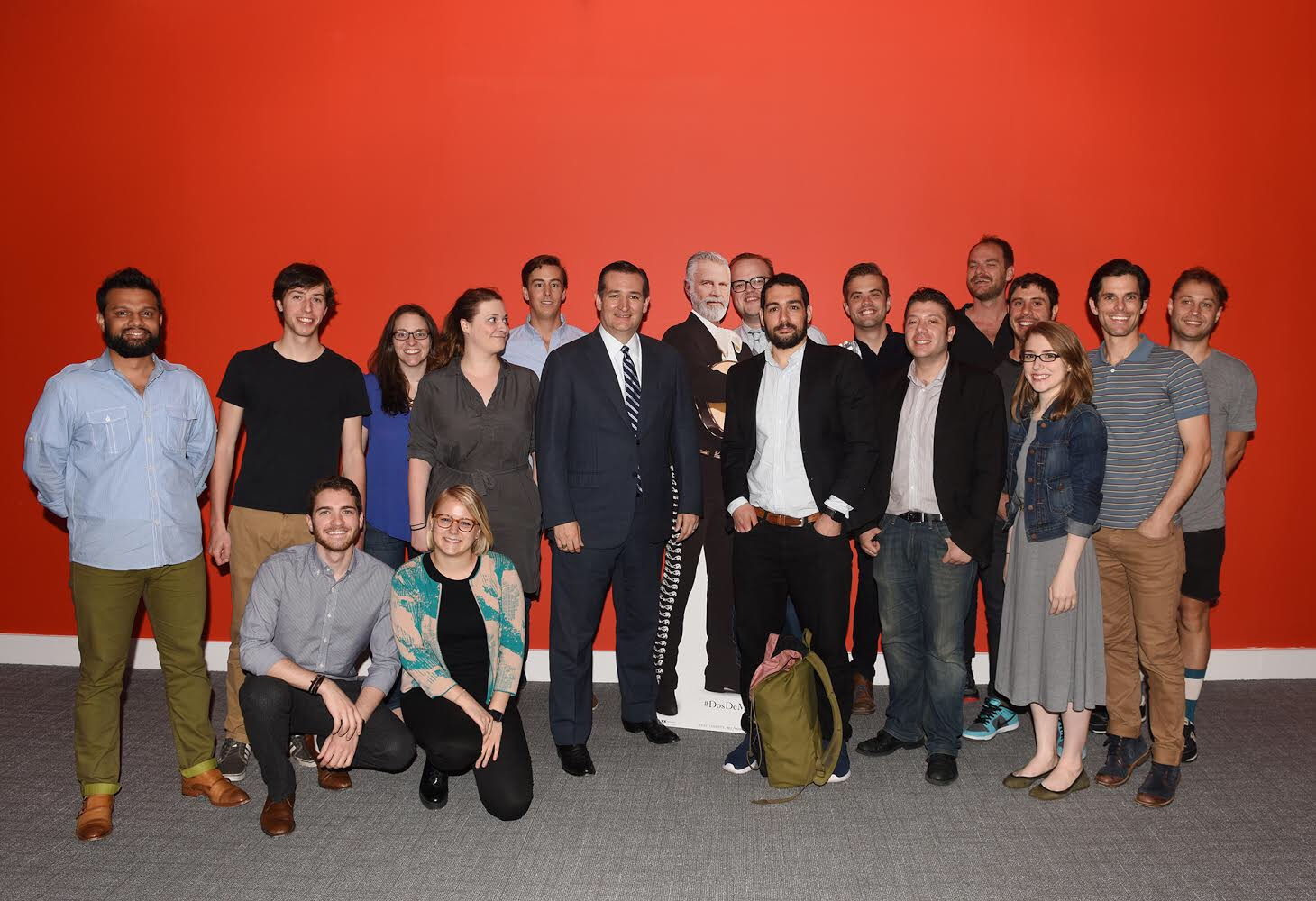
“It’s all happening.”
Julia Reinstein, senior reporter: I remember one time there was someone running around the office in a ghost mask scaring people, and I later found out it was Bella Thorne. Another time, I was playing with several puppies that were in the office for a video when Seth Rogen suddenly popped his head out of a room. He made direct eye contact with me as I was lying on the floor covered in puppies and nearly crying.
Johana Bhuiyan, former tech reporter: BuzzFeed is probably the only place I could make eye contact with T.I. while trying to decide which pieces of day-old sushi from yesterday’s free lunch were likely to hurt my stomach the least.
Emma Loop, former BuzzFeed Canada and politics reporter: I was in the New York newsroom one time – I think I was there working with the investigations team on some money trail stuff. All of a sudden I heard singing. As I followed the sound, I discovered Hanson — yes, the ’90s boy band of “MMMBop” fame — playing a concert in the canteen.
Jason Wells, executive editor of news: At the Beverly office In LA, Paul Rudd (a crush for many of us) visited the office for a photo shoot to promote a movie. We all positioned ourselves in the warehouse-open floor plan office to get as good a view as possible when he was ushered through to the photo set. He arrived, we all freaked out on Slack. Then Paul saw the Slack conversation in the studio room on an employee’s laptop and started typing in the channel, which meant he saw all our thirsty slacks. He then marched out into the office area and yelled something like “How DARE you all objectify me!” before laughing. We all freaked out.
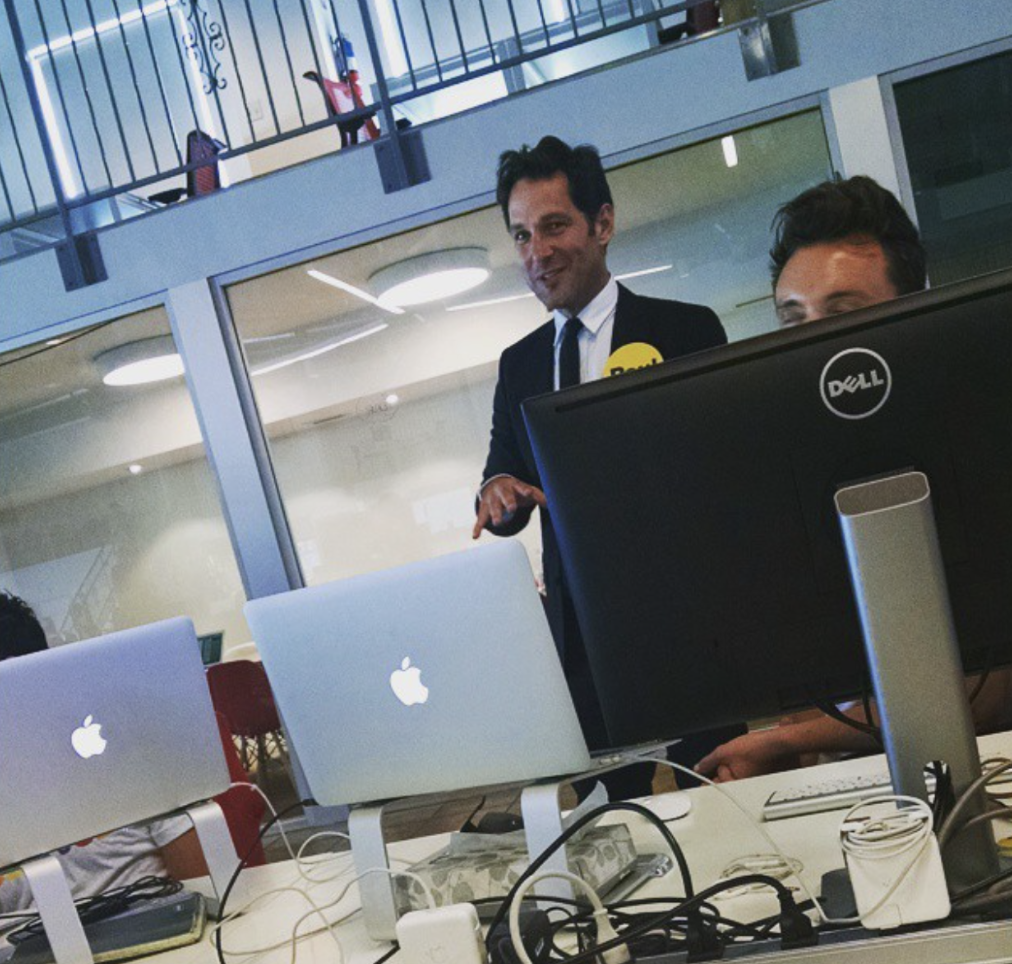
Paul McLeod, former politics reporter: During the 2016 Republican National Convention, BuzzFeed News threw a big, swanky party on a rooftop hotel in downtown Cleveland. I look over and see Rudy Giuliani in the corner drinking scotch and smoking cigars. Our DC bureau chief, John Stanton, was a tall, heavily tattooed man who wore black and lots of skull rings. Lovely guy, but apparently Giuliani’s bodyguards thought he was some kind of anarchist because when he approached Rudy to ask a question they tackled him to the ground.
David Mack, senior reporter: On the night of the 2016 election, I was working in the newsroom in New York. We were doing a huge live show on one of the social media platforms (with dozens of professional outside crew members) and they had planned all this fun stuff. Quickly, the mood turned. That morning, I’d gone for a jog and thought to myself, On the random chance that Trump wins, I should just publish a post of people swearing different swear words on Twitter. I did end up getting to publish that at 2:45 a.m., but Ben made me put the headline “Well, Fuck” in quotes so it didn’t seem like it was us saying it — which I think was cowardly! I went home, stared at the ceiling for two hours, came back to work, and Ben, to his credit, gave an inspiring speech to the newsroom about getting started on the most important work of our careers.
Steve Kandell, former features editor: On election night 2016, Charlie Warzel, Miriam Elder, and I were talking in the hallway right as things were just starting to turn and feel weird. The Decision Desk dude walked out of the bathroom and said, “It’s all happening,” and he was just in there throwing up. That seemed bad.
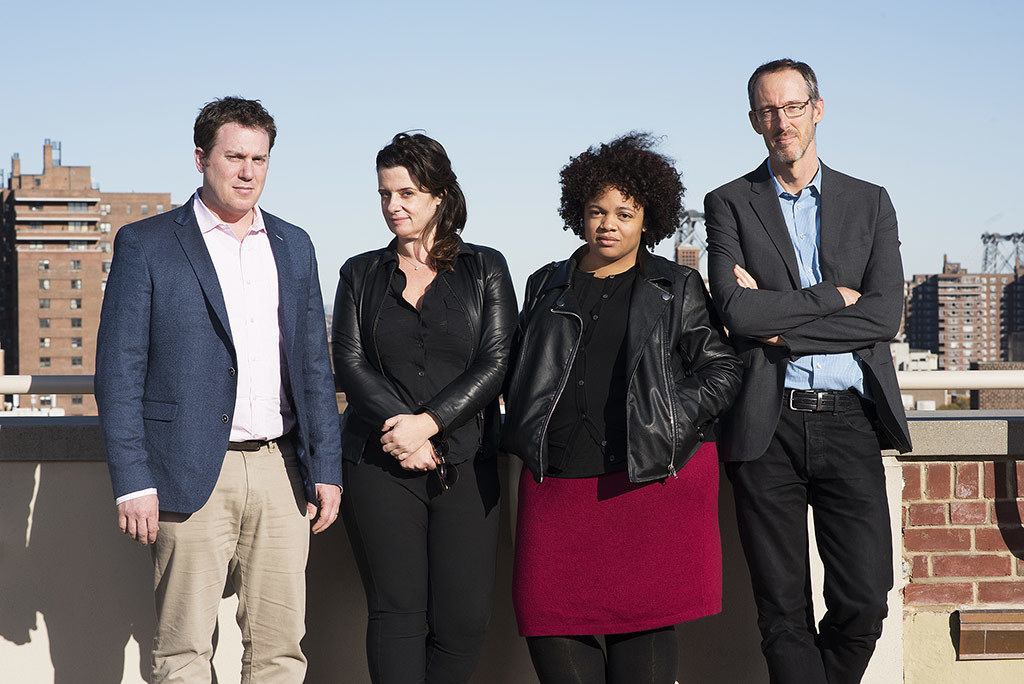
Hayes Brown, former deputy world news editor: My desk in 2016 was right in front of the executive suite of offices. I remember seeing a flurry of activity one night, with Ben Smith, Miriam Elder, and Mark Schoofs all hustling around with a clear sense of urgency but nobody letting on why. At one point, I looked over and saw Ben crouched down typing away at a laptop perched on a shelf only a foot or two off the floor. Minutes later, The dossier was online.
Matt Mittenthal, communications director: I’d just accepted the job of running comms for BuzzFeed News but hadn’t started. Ben published the dossier at 6:20 p.m. on Jan. 10 [2017], then sent me this:

Clarissa-Jan Lim, senior reporter: On March 6, 2020, Tom Namako sent out an email telling us to start bringing all our stuff home every day — laptop, mouse, keyboard, etc. That was when we were still doing stories of couples navigating coronavirus-era dating and working from home together, and I thought BuzzFeed was maybe a bit too panicked about the pandemic. I’ve never been more wrong because a few days later, on March 11, everything happened.
Albert Samaha, senior culture reporter: I get a call from our science editor, Azeen, asking if I can go to New Rochelle to report on the first coronavirus containment zone in the US. On my way up there the following day, I dropped by the office, where Tom Namako gave me a bunch of safety gear. For the mask to fit properly, I had to shave my beard, which probably stands as the greatest sacrifice I’ve ever made for this company.

“Can we spend this?”
Mat Honan, former San Francisco bureau chief: Something I figured out pretty quickly was that — at least in those days — there was no budgetary limit on ambitious work. Incredible! The answer to “Can we spend this?” was always “Yes” if it was a good story.
Caroline O’Donovan, former tech reporter: Mat Honan told the San Francisco office he had this big surprise. It turned out to be the BuzzFeed Open Lab, a giant glass box where we paid these engineers and nerds $100,000 a year to make stuff with projectors and animatronic stuffed animals. It was supposed to be like a media tech incubator; Mat said it would have soldering irons and welding equipment. When it opened we threw a big party and people kept crashing their hoverboards into the walls.
Tom Warren, investigative reporter: More than once I would ask an editor if it was unreasonable to take a source to a £150-a-head restaurant. If the source was good enough, the answer was always yes. My time at BuzzFeed meant my tastes have become expensive. But alongside all the wild spending, the truth is that a lot of money was spent on reporting. Other newsrooms asked journalists to take risks, without considering their safety. We had an excellent security team to look after us, and editors would spend thousands chasing a story. That meant we often beat the big players like the New York Times or the Guardian, which was a delicious feeling.
Rosie Gray, former politics reporter: In my recollection, 2014 to 2016 was really the peak in terms of the feeling that there were unlimited resources. Even the most far-flung, expensive reporting trips would get approved, and we were constantly hiring. By that point I was in DC and we were doing these BuzzFeed Brews events with various notables and having big White House Correspondents Dinner parties. This was the era captured in that Awl thing that was like “I hate my life because I don’t work for BuzzFeed.”
Veronica Dulin, DC office manager/editorial assistant: Holy shit, the WHCA Dinner afterparties. As someone who saw the budgets, they were all open bar for hundreds of people, including a ton who weren’t on the guest list, and which everyone at the company could bring like 10 people they wanted to. They’d lay off journalists …then throw this fucking rager for tens of thousands of dollars in April in order to get what, access for the journalists we’d laid off?? It was absolutely insane and only done for clout. They threw those after the Facebook bubble. What were they doing???
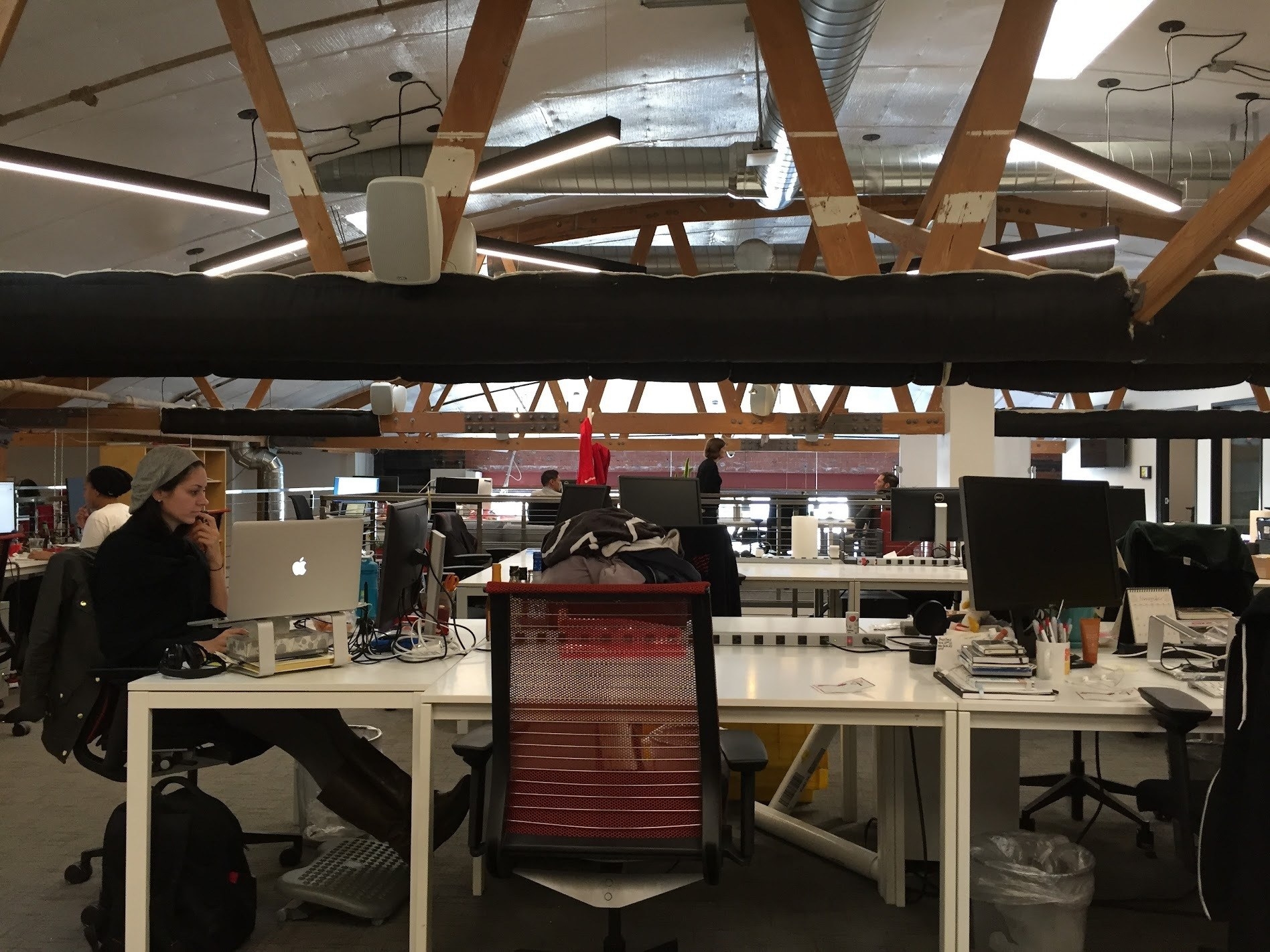
Karolina Waclawiak, editor-in-chief: When I first started in the Beverly office in LA in 2016, I remember being told we had a valet, and I was so confused. This was normal? Yes, apparently it was. We had several valet workers parking and getting our cars for us every day. Some of the people who worked in that office were in their early 20s and had never worked anywhere else so they thought this was normal, I guess? I had heard about excesses in tech companies but I had to call my immigrant parents to tell them we had a valet who was parking my car every day because it was so wild to me. And I remember my mom asking how we were making money to pay for all of this, and I said, “Who knows?”
Jessica Garrison, former investigations reporter: There was fresh Pressed $9 juice several times a week delivered to the LA office.
Ken Bensinger, former investigative reporter: Peak tech company excess moment might have been the holiday swag announcement in 2014 (or was it 2015?) when Jonah did a show and kept saying "But wait, there's more!” We all got duffel bags, sweatpants, sweatshirts, and socks, and a weird little key fob with the number of employees on staff at the time. Then, in 2016, he did the holiday swag announcement with his hoodie pulled up and it looked like a hostage video, and that's when we knew the wave had crested and moved on.
Katie Notopoulos, senior tech reporter: An incomplete list of things BuzzFeed gave all employees while I was there:
iPad Mini
Apple Watch
Winter pompom hats in six-plus different colors, one for each year
A woven blanket with the viral arrow
A fleece blanket that was just colorful
Three-plus pairs of BuzzFeed branded socks
Three-plus tote bags
Five T-shirts with different city office names on them, all in one year
One longsleeve BuzzFeed shirt
Uncountable T-shirts tied to events
Two BuzzFeed hoodies
One pair of BuzzFeed sweatpants
Two pairs Bluetooth over-the-ear headphones, branded
A BuzzFeed backpack
A BuzzFeed duffel-style gym bag
Several drink koozies
A limited-edition print of a drawing of a cat made by a machine by artist Cory Arcangel
Rosie Gray, former politics reporter: There was the infamous cat drawing by Jonah’s friend Cory Arcangel that we all received as a holiday present one year. It was literally a really basic line drawing of a cat, like a doodle, on computer paper. Each copy was individually numbered, and Jonah claimed these artworks would appreciate in value. We were dying laughing about this. I think I still have it somewhere.
Claudia Koerner, deputy director breaking news: The LA Christmas party was at the Wizarding World of Harry Potter one year, presumably through the deal we had with NBC Universal. We had the run of the park, and a bunch of us on News just rode the roller coaster again and again. There was food and an open bar, but if you wanted to spike your Butterbeer, you had to do it on the sly.
David Mack, senior reporter: For the first few years, we also had Pride parties at massive New York City event spaces. These weren’t just for BuzzFeed staffers, either. I think they were cosponsored by alcohol brands, but it was still nuts. At my first holiday party at Webster Hall, I got so drunk (everyone was) that I made a point of thanking Jonah in person for all the drinks, then climbed on a little platform all the gays were dancing on. When I stepped off, I slipped on a puddle of booze and hit my ribs and was injured for weeks. As the years went by, the Pride parties ended, and the holiday parties became smaller and smaller. Once they stopped allowing us to bring our partners, I was like, Uh-oh.
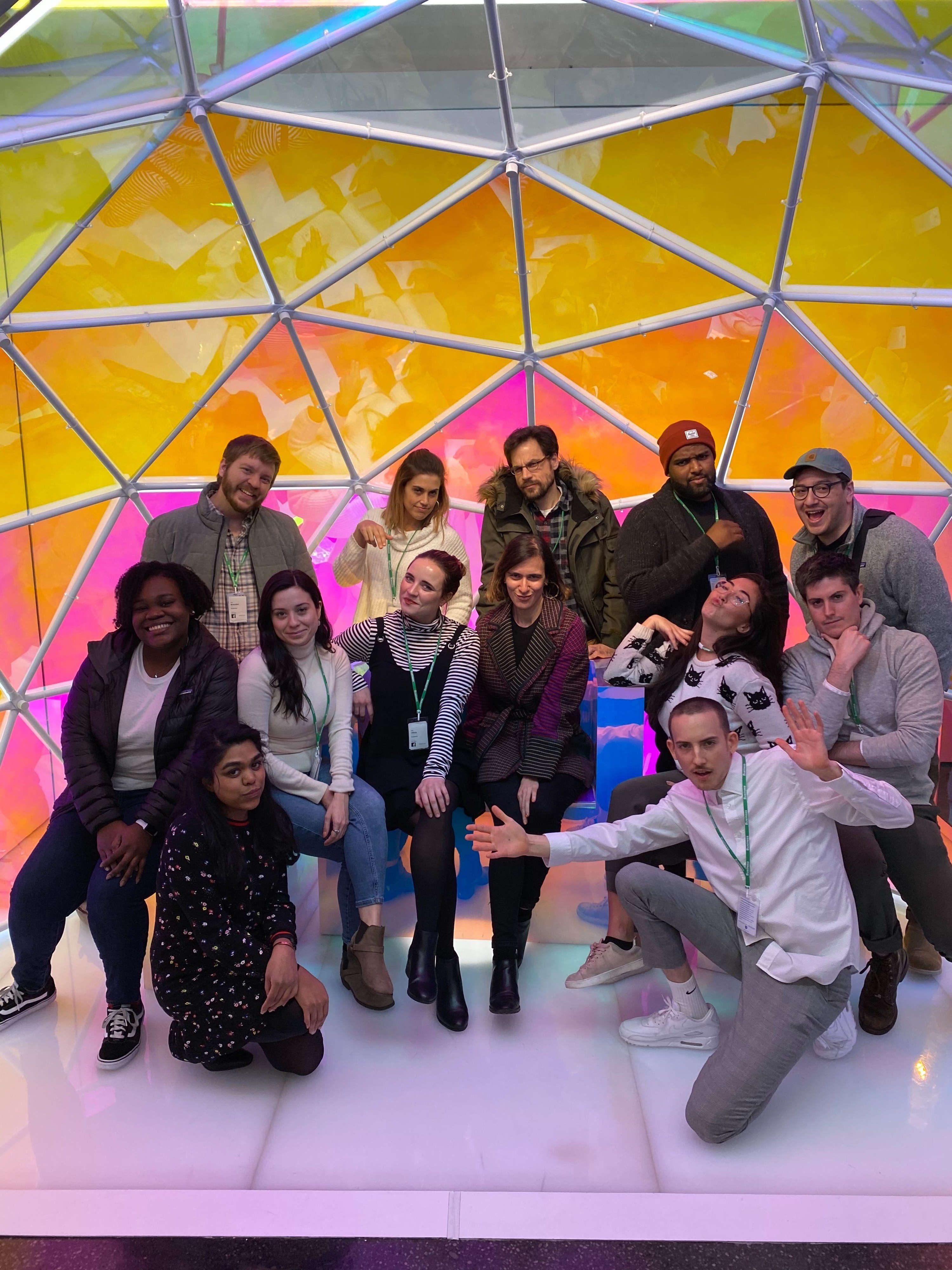
Jason Wells, executive editor of news: I’ll never forget how Ben Smith sent me to help staff up and resettle our news team in Sydney with explicit instructions to use my corporate card to wine and dine the staff, make everyone feel special, and meet with potential business partners. I was there for a month and did just that. A few months later, after I returned, we laid the entire team off to save money.
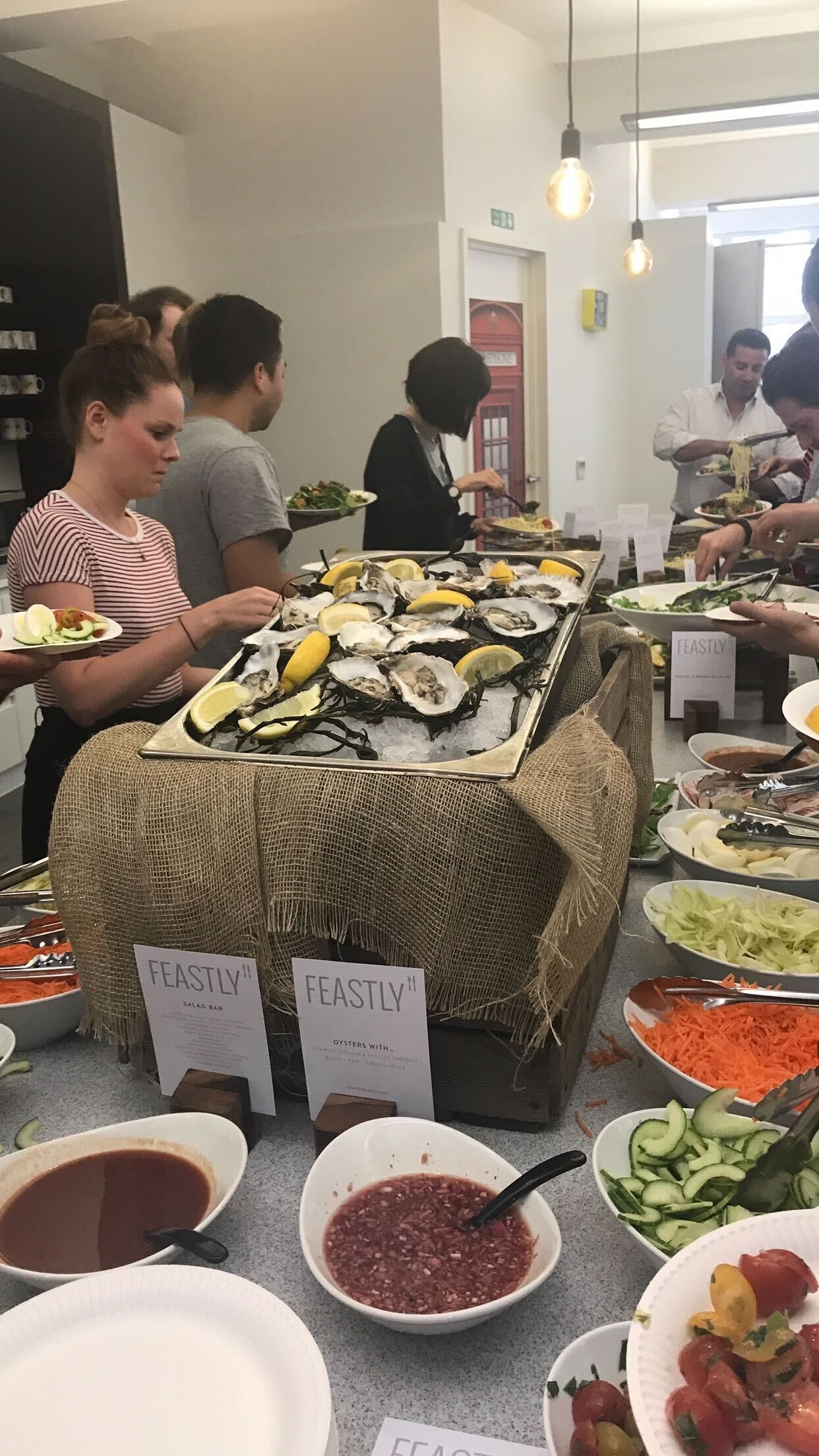
Ikran Dahir, internet culture reporter: I remember the day the London office got oysters for our free lunch like it was yesterday. It was May 2017. Everyone laughed when we saw the lunch announcement in the morning because surely not actual oysters? But there they were at lunchtime, and not many of us ate them. That wasn’t the only time a free meal at work was slightly fancy. On one Friday, there were breakfast mimosas! All of this felt very ridiculous when redundancies in the UK were announced just a few months later that year.
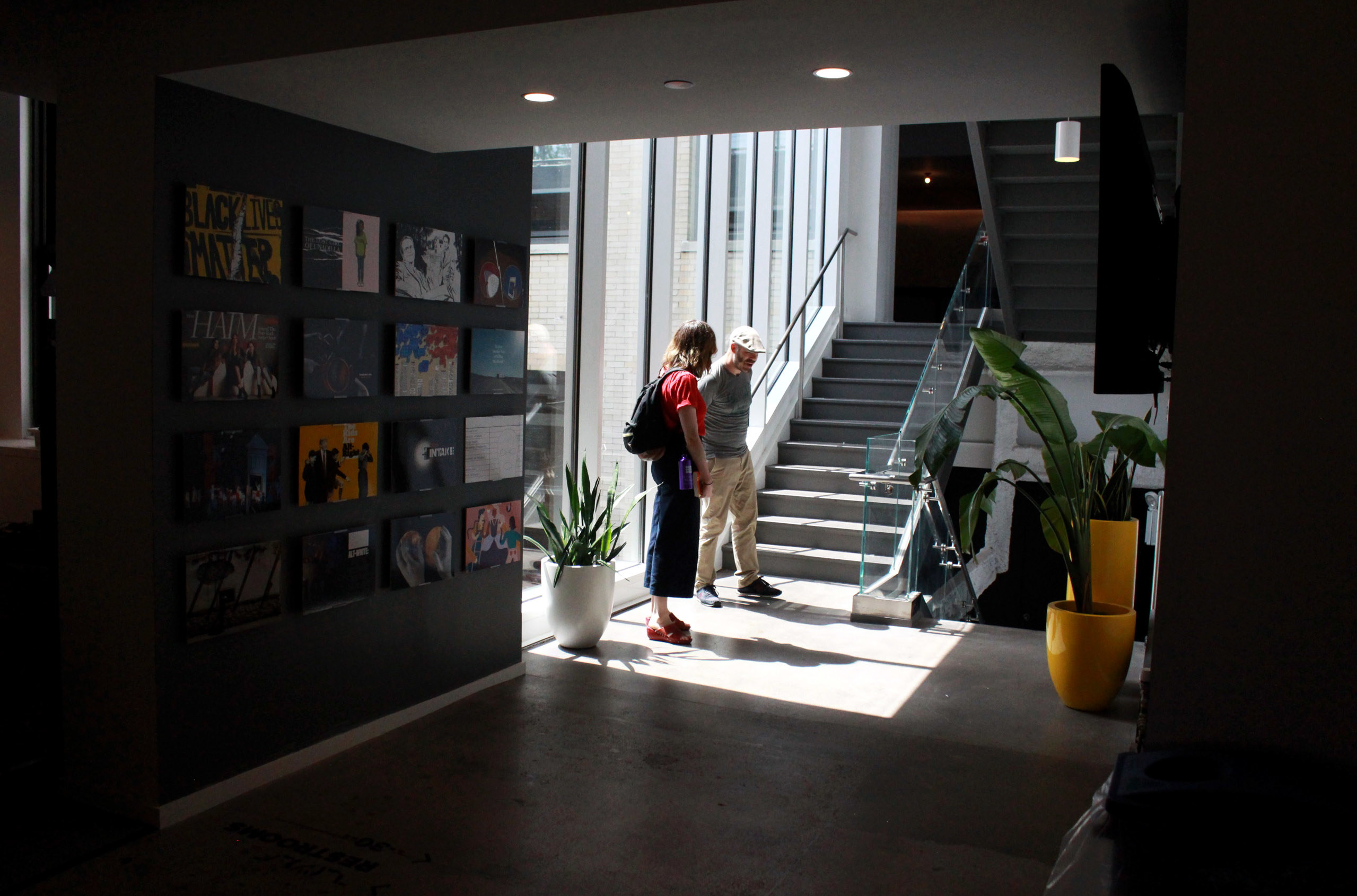
“Let’s wait until the water situation is resolved, and then we will lay you off.”
Joel Anderson, former sports and national reporter: I left in the summer of 2017, before things really got bad. But I always, always suspected that things weren’t sustainable. I’d worked in the media long enough to know that eventually we’d have to make money and we kept hiring so many people. I’m probably getting this wrong, but I think we hired roughly two people a day from 2014 to 2015. Opened lots of offices overseas and domestically. Everyone seemed to understand the ride was going to be fun, but short. My editor — one of the loveliest, best people I know — always used to say: “Joel, just spend the money!” Which was a nice thought, but it seemed so shortsighted. I’d come from places where they’d taken out coffeemakers and even cut back on toilet paper. The bills were always going to come due.
Tom Warren, investigative reporter: I think the writing was on the wall in the international offices far earlier. Colleagues we worked with in France and then Germany were unceremoniously sacked, and the London office faced wave after wave of heartbreaking layoffs. There was a lot of anger in those early sackings — we all had a sort of codependent relationship with BuzzFeed, and people felt like they were being dumped.
Adam B. Vary, former entertainment reporter: In October 2017, the New York Times and the New Yorker published their blockbuster stories about Harvey Weinstein, and Ben, who’d spent years treating the Entertainment News desk with benign neglect, suddenly became fixated on the fact that we had not, somehow, landed the biggest and most difficult entertainment news story in my lifetime. By the end of that month, our team was split up, our editor (my third — of five!) resigned, and an internal memo was leaked to the trades which singled out “the holes in our Weinstein coverage” for the changes. It felt punitive and arbitrary, and I’m clearly still a little mad about it, but more importantly, it burst that magic feeling of my first four years at BuzzFeed. I realized how precarious everything actually was, so when the first round of layoffs hit in 2019, it just felt like the trajectory of the place was no longer ascendant.
Julia Furlan, former head of audio: One afternoon, water started pouring out of a pipe in the ceiling right over the Pod Squad desks, so we had to move all our stuff. A media reporter from the Wall Street Journal had already started asking our producers if we were getting laid off, and the execs were like, “Let’s wait until the water situation is resolved, and then we will lay you off.” Instead I said, “No, do it now,” and so they unceremoniously called us one by one into their office as the water continued to pour into the newsroom. They laid off the whole team; it was ice cold. They said we didn’t have the numbers, but the truth is they didn’t have any idea what they were doing with us.
Albert Samaha, senior culture reporter: What really birthed the union was when management shuttered the Pod Squad in October 2018. Every person on that team was beloved, extremely talented, and doing exceptional work — and on top of that, these were mostly women and people of color. The news was shocking, and the meeting in the newsroom when Ben and Shani announced it was gutting. A bunch of people were crying. I really couldn’t believe that leadership had no idea how to make podcasting profitable, when we had such an impressive head start in a direction the industry was so clearly going in.
It was the moment I lost trust in the folks making the big decisions. It was the moment that radicalized me, from someone who casually supported the idea of a union to someone volunteering to help lead the organizing effort. I went to my first union meeting that night, and the NewsGuild conference room was filled with other colleagues who were also making their first appearance. Before that day, just a handful of colleagues were actively participating in the effort. Afterward, damn near the whole newsroom was on board.
David Mack, senior reporter: Once we started closing international offices (RIP BuzzFeed Canada, BuzzFeed France, BuzzFeed Mexico, BuzzFeed News Oz), it was clear to everyone we’d expanded too fast and the good times were coming to an end. We still were trying new things, but the years of unchecked spending were over. Gradually, we became more like an establishment outlet and less of an underdog startup. When Ben left for the Times, I realized there were the Ben boom years and the Ben bust years, and I think he’d admit that he wasn’t having as much fun towards the end with our first mass layoffs in early 2019. Those were horrific. I saw managers weeping. I wept. But we soldiered on as best we could, even if we did spend the next few years trying to fight as we were getting limbs chopped off like the Black Knight from Monty Python. Despite all this, the closure comes as a shock. We were told we had more time, and we were hitting the goals they’d set for us.
Venessa Wong, senior culture reporter: BuzzFeed’s business model kept changing. When I joined in 2015, native advertising seemed like the future. Because we weren’t relying on banner ads and pop-ups like other sites, our story pages were so clean. Yet from the perspective of someone far away from the decision makers at the company before it was publicly reporting financials, the business seemed off. The company had already had layoffs in 2017 because it had failed to reach revenue goals, and many more rounds would follow. When BuzzFeed spun off a separate news website (BuzzfeedNews.com) in 2018, I was seriously worried that we were being cut off from the lifeblood of BuzzFeed.com, and its massive audience, not to mention its sales and business resources. When BuzzFeed acquired HuffPost in 2020 and were told we would continue to operate completely independently and compete with them for stories, many of us worried how long the company would want to run two newsrooms.
Gina Rushton, former reproductive rights reporter, Australia: I wouldn’t change a second of it, except maybe for the inevitable end to us being a forgotten outpost when we got unceremoniously laid off, at 2 a.m. our time, on my birthday, in the early scary days of a pandemic. This is embarrassing but I remember trying to calculate how my salary compared to the cost of the frozen yogurt machine in the New York office.
Rosie Gray, former politics reporter: I returned to BuzzFeed in 2019 after working for the Atlantic for a couple years. I had really missed the atmosphere and energy I remembered from BuzzFeed’s heyday. But it was clear right off the bat that things had changed a lot. Even before I officially started, there was a round of layoffs. Things felt less freewheeling and more tense. This was the year we unionized, which was so important considering what happened the next year.
2020 is when it really started to get dicey. First Ben announced he was leaving for the Times, right before the Iowa caucuses. That really threw us on the politics team — we were all really angry, not so much at the concept of Ben leaving at all, but that he would check out at the most awkward moment possible. Then obviously the pandemic hit soon after and it was chaos. We fought for the work-share agreement instead of layoffs, and I’m still really proud that the union was able to save those jobs at that time. Even if it didn’t last. My memory of 2021 to 2022 is basically of a place that was struggling to find its footing at all. By the time they offered buyouts last year, I was ready to leave. It wasn’t the same place I had loved so much.
Clarissa-Jan Lim, senior reporter: I’d always heard that Asian employees at BuzzFeed would get mistaken for one another. Towards the end of 2021 when people started trickling back into the office and traveling to New York for summits with their respective desks, that happened to me, twice, in the span of a week. Two different white men at BuzzFeed News confused me for two different Asian women in our newsroom. Only one apologized!
Sam Henig, former executive editor and interim editor-in-chief: When I led the search for a new Editor-in-Chief last year, Karolina [Waclawiak] wrote in her memo that she wanted BuzzFeed News to embrace being “a little chaotic.” She was the perfect person to lead BuzzFeed News into its next chapter, to bring back that fun crazy energy from the early Ben Smith days — the kind of delight that spills onto the page. Given Karolina’s invigorating editorial vision and the strong plan we’d worked on with colleagues across the company to increase and diversify revenue, I left in the fall thinking that some of the best days for BuzzFeed News were still ahead.
Scaachi Koul, senior culture writer: Near the end, I felt a little like Chicken Little. I was telling everyone at work, “I think something bad’s about to happen.” I have, historically, been right about everything, but I’ll tell you I wasn’t thrilled to be right about this one. The thing that worried me the most was our travel budget disappeared practically overnight. Our earnings reports, now abundantly public, were looking grim. They changed the granola in the office to corn flakes. This, I thought, spells doom. But the tough thing about working in media is that a lot of things are doom-lite, and then the real doom comes and all you can think is: I can’t believe I was right about this.
Zia Thompson, audience engagement editor: One Monday in April, our office manager said Wednesday’s lunch would be from a “cutting-edge, robotics-powered mobile pizza restaurant created by a team of former SpaceX engineers.” I normally would’ve stayed home, but I was very intrigued by the idea of robot pizza. That Wednesday, I made the trek to the office and at lunch, I ate a pizza slice so mediocre, that had I not known it was digitally printed, I would’ve guessed it was.
The next day, BuzzFeed News shut down.
Brandon Wall, director of newsroom strategy and experiments: There’s actually one thing that my old boss Michael Rusch, who went by “Weed Dude” online, said to me that stuck with me over the years, and was the first thing I thought of when I found out BuzzFeed News was being shut down. He said something to the effect of “I’m asking you to leave your newspaper job to get on a rocket ship. The thing about rocket ships is that they go fast, but the ride can come to an end very unexpectedly. BuzzFeed might last a year, it might last five, it might last a century, we just don’t know.” I really appreciate the poetic foreshadowing of a guy who went by “Weed Dude” online telling me in 2015 that BuzzFeed might abruptly stop like a rocket one day, and then a SpaceX rocket blew up the day BuzzFeed News was getting shut down…. on 4/20/2023.
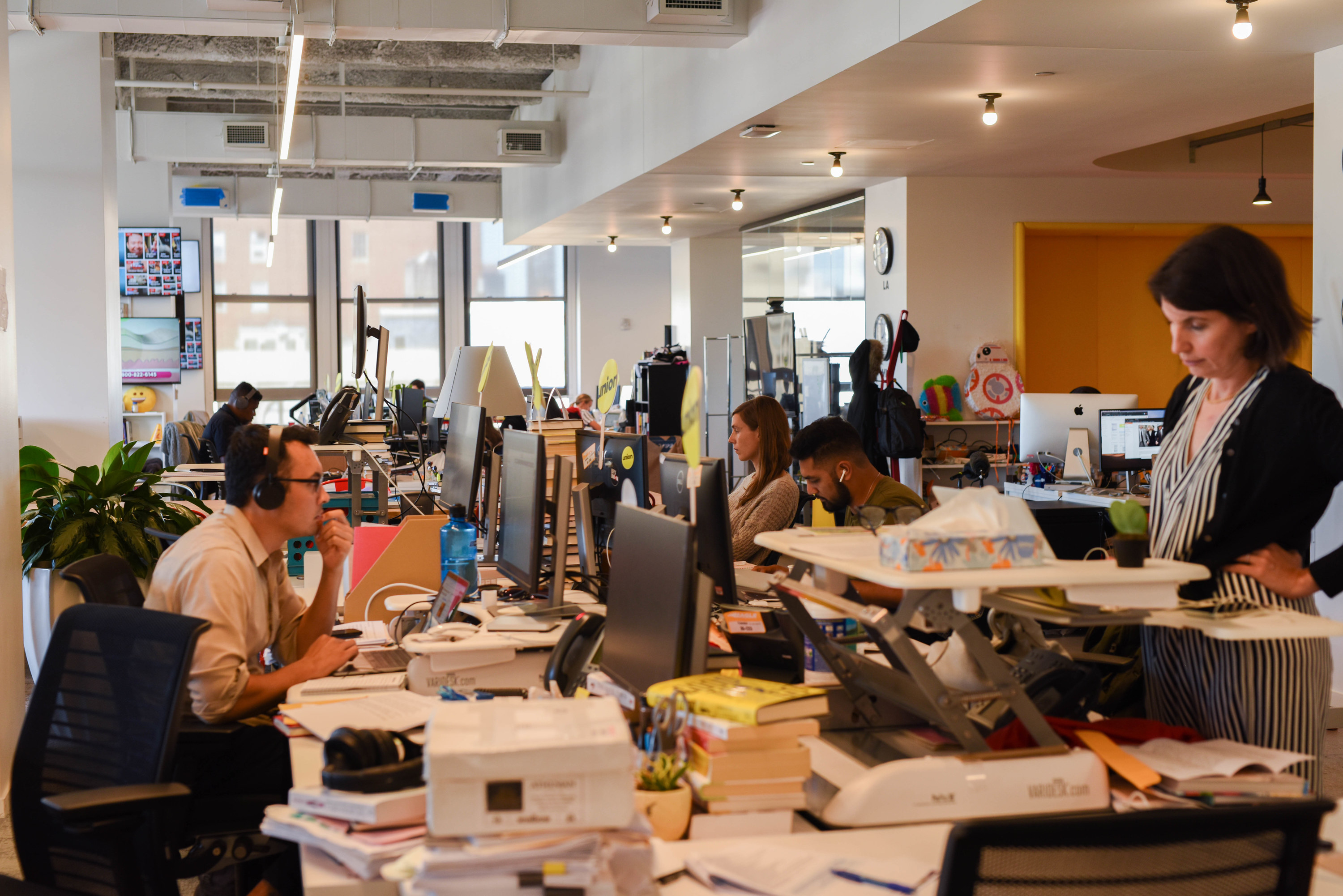
“We loved news and weren’t snobs.”
Clarissa-Jan Lim, senior reporter: I wasn’t here for the golden years when people were just throwing money around, but I think that spirit of adventure continued even when the purse strings grew tighter and tighter. I went to Charleston for a week just to see if there was an angle to pursue on a topic I was reporting on. Days before I traveled to Michigan to cover the midterm elections, I wrote about an Air Force plane drawing a dick in the sky. You could write the most ridiculous headline and your editor would be like “That’s the one.”
Julia Reinstein, senior reporter: I believe that was actually one of three separate stories that three of us wrote about sky dicks. We never let a sky dick go unreported.
David Mack, senior reporter: I have never had as much freedom and fun doing anything in my life. In 8.5 years, I never had a single idea rejected. Nothing was off-limits. They sent me to a poppers factory, for fuck’s sake! I wrote a stupid photo story about Trump sitting in a truck on the White House lawn, turned to my editor, Tom Namako, next to me and said, “You have to trust me. You need to publish this.” And he did! It was such a viral hit that the very next day BuzzFeed turned it into a children’s book. And I got a cut. It was nuts. Where else would do that? I still have a few hundred copies under my bed in boxes. I give signed copies to friends when they have kids. I may never have a better job.
Matt Berman, former politics editor: My child will not stop crying if I don’t repeatedly read him David’s Trump truck book.
Zoe Tillman, former politics reporter: I loved that we had the freedom to write the way we actually talked to each other and to be honest with readers. It built trust. One of my favorite headlines was “There Was Drama At Court Today And Maybe It Involved Mueller’s Investigation But Who Knows.”
Tom Warren, investigative reporter: It’s quite reasonable that businesses don’t spend unlimited amounts chasing stories. But for many years BuzzFeed inverted that rule. It meant you were never limited by resource, only by your imagination. We did world-beating investigations that freed people from prison and changed laws. Professionally we won a swath of awards — but the thing I’ll really take with me is that I made friends for life. The experience of working here, whilst sometimes frustrating and often stressful, was a dream come true. The rest of the news business looks insipid and gray in comparison.
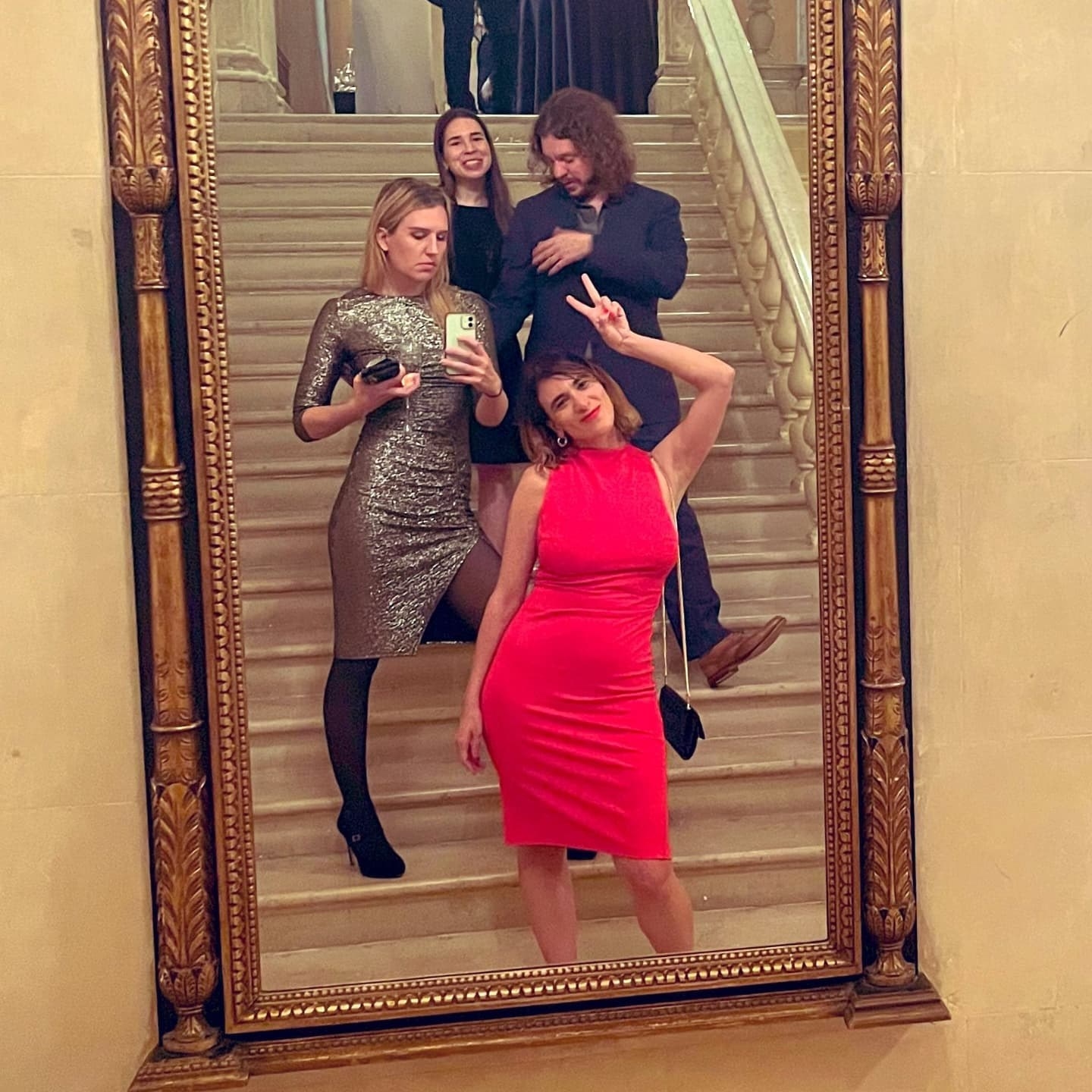
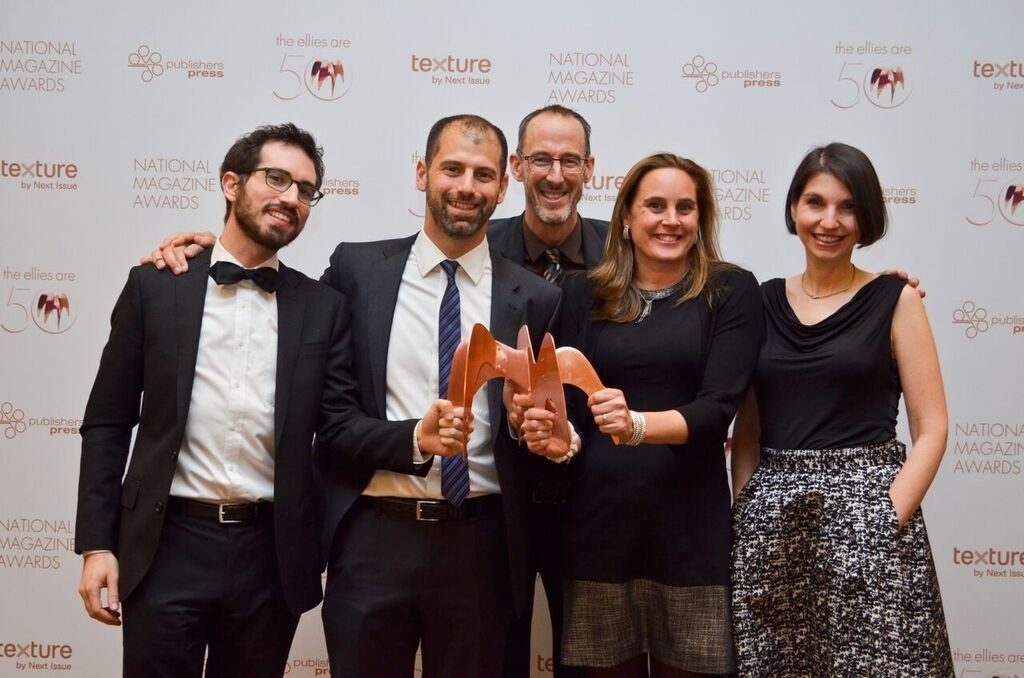
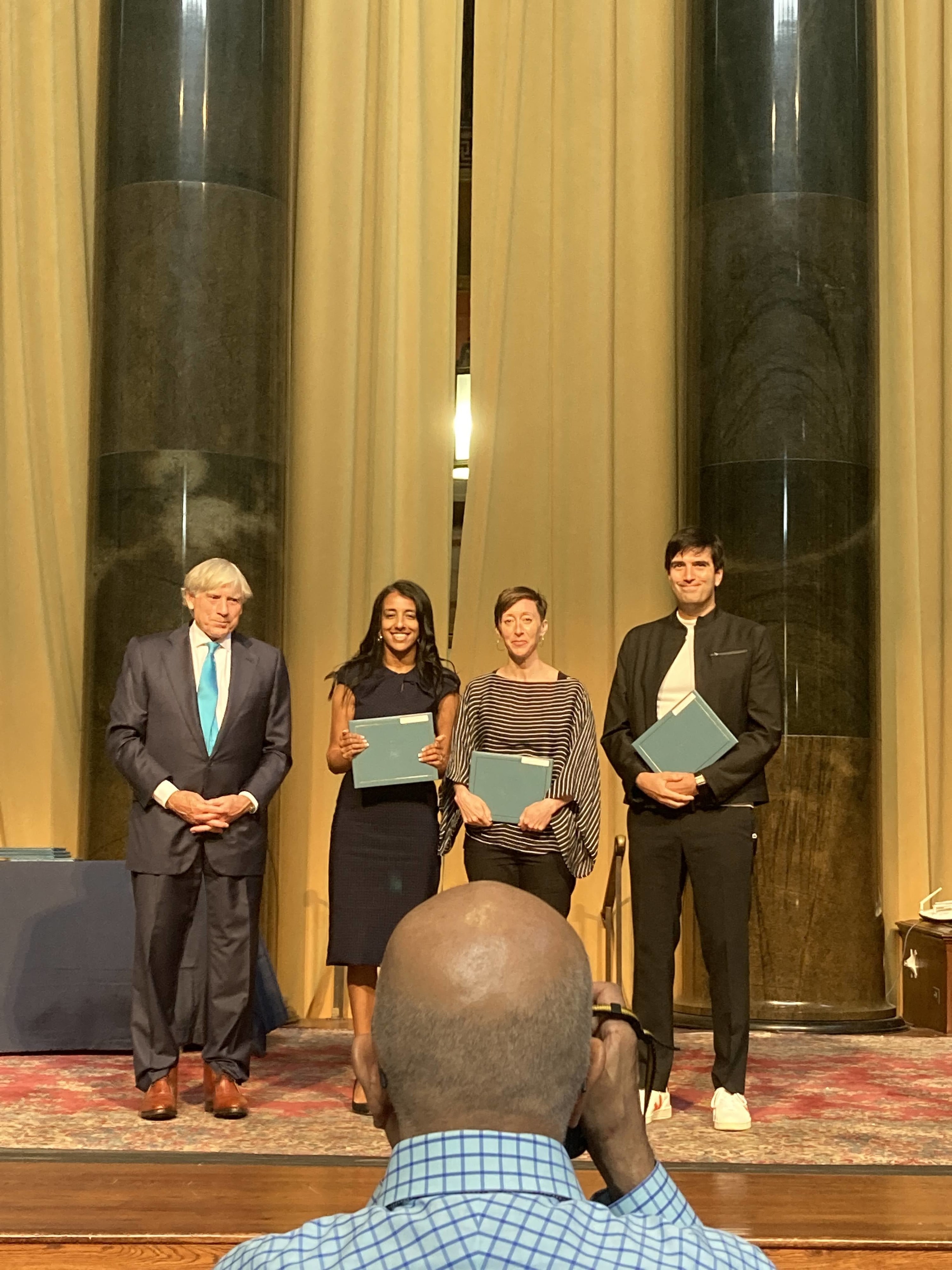
Monica Mark, former West Africa reporter: In April 2015, I got an email from BuzzFeed’s foreign editor Miriam Elder, asking if I’d be interested in talking about what it was like to become part of the World team — “we're all about allowing travel and creativity and a range of stories” is how she described it, which doesn’t even begin to do justice to the wild, creative ride that was the next five years I spent as BuzzFeed News’ first Africa correspondent.
I got to cover things no one else was doing at the time, and even some things I haven’t seen anywhere else since. I mean, I have yet to see someone explaining inflation in a West African nation entirely using GIFs. Like everyone else on the amazing World team, I also got to break news that left legacy media eating dust, like on the Special Forces raid gone wrong in Niger. And I got to write longform stories about crazy periods in West African history that wracked up a couple of million — millions! — of views. I just don’t think there’s anywhere else on the internet that political stories about Africa are getting that many eyeballs! Honestly, I still get emotional thinking about what this tiny World desk team achieved in such a short time.
Amber Jamieson, internet culture editor: We always treated young people as people, which frankly most publications don’t. After a school shooting in Santa Fe, Texas, I reached out to some teens who survived and had been posting on Twitter to see if they would meet up for a chat. They said sure, as long as it wasn’t at their school, where a shooting had occurred three days earlier. I said of course not, and we met at a local park. They told me the TV networks told them they could only film an interview in front of the school because their equipment couldn’t move — I knew the network had multiple teams there and it was painfully clear that they just wanted these traumatized teens, who'd never interacted with the media previously, to cry on camera. We always made sure that teens knew they had control over their own story.
Claudia Koerner, deputy director breaking news: In the immediate aftermath of the Uvalde school shooting, we sent out a push alert and tweet that the cops had fucked up. It was the truth, everyone was thinking it, but we actually got to say it. Breaking news can be such a punishing job, but that ability to just tell the truth made me proud to do it at BuzzFeed News.
Ben King, art director: We had so much leeway to do so many fun and incredibly stupid things, and I really think we did a lot to push both what was possible and expected of an online news outlet. Personally, it was the range of work we did, as well as the absolutely furious pace, that made me love it so much. On a given week, we might be working on a massive investigation, setting up a celebrity photo shoot, designing a map or infographic for a breaking news event, or getting FOIA’d documents from the Mueller investigation at 6:30 p.m. on a Monday and scrambling to get a story up.
Maybe one of the best ways I can sum up what we did: One day during the run-up to the 2016 election, Saeed Jones told me he was looking to publish a piece of satire by James Hannaham. The story was written as Trump’s notes to himself for a speech, which (in the way it was submitted) wouldn't really translate very well to our CMS. At the time, we had this kid, Mark Davis, freelancing for us, who had previously worked at Font Bureau as a type designer. He arrives at the office around 10 a.m., and the first thing I said to him was, “Today you’re designing a font based on Donald Trump’s handwriting.” And he did! And we published Hannaham’s piece using that font, then made the font available for anyone to download. It was all terribly stupid, and after Trump won, the joke was significantly less funny. But it was a tremendous experience, and something I can’t imagine any other news outlet doing.
Kenneth Bachor, photo editor: BuzzFeed News was a dream job for me. Bouncing ideas off editors and writers at BuzzFeed News was a pleasure because I knew I wasn’t going to be judged — it felt nice to collaborate and feel comfortable, which is sometimes not the easiest feeling to have in a newsroom. We did a feature on male sex dolls and their owners. We had behind-the-scenes access to a sex toy manufacturer in California and assigned photographer Skyler Dahan to spend a day with the male sex dolls — the story was an SPD58 Medal Finalist this year.
Katie Notopoulos, senior tech reporter: “Punching above our weight” is something I would hear bosses say or I’d see in descriptions of BuzzFeed News. I never saw it that way; I think we punched exactly at our weight. Despite what may have been Ben’s dream, we never competed with the New York Times or legacy outlets; we were always playing an entirely different game. Not better or worse, just different. We succeeded when we looked for stories in places no one else was looking precisely because we couldn’t compete with legacy outlets on the main story of the day. You couldn’t just report The News, you had to be creative, you had to be nimble. I think that’s why so many former BuzzFeed News people have succeeded at big legacy outlets — they have that creativity ingrained in them, plus that institutional power behind them. It’s like, If you thought they were good before, wait till people actually answer their phone calls.
Joel Anderson, former sports and national reporter: It was the only time in the world that I’d worked somewhere with the money to really and truly unleash its talent and resources. I almost hate to name any of them. Tracy Clayton and Heben Nigatu showed what was possible with podcasting. I remember when Quinta Brunson was doing funny little videos for us. Saeed Jones. Albert Samaha and Melissa Segura literally got people freed from prison, among other things. Katie Baker. Ashley Ford. Miriam Elder. Lisa Tozzi. John Stanton. Andrew Kaczynski. Mike Hayes. Katie Notopoulos and Ellie Hall were genius at finding weird stories from the internet and explaining why they mattered offline. Jessica Garrison. I should stop because I’ll be sick about overlooking more folks. I also had a deep appreciation for the folks who excelled at making lists and videos, because I realized that, for a long time, they paid down some of our bills. I’ll forever be grateful about what we built there, and really bummed that it didn’t last.
Sarah Mimms, former DC editor: I spent five years at BuzzFeed News and left in 2022 during the previous downsizing, in a decision that broke my heart. It was a real blessing to be covering politics at BuzzFeed News during the Trump presidency; we were a “failing pile of garbage” with a lot of freedom that made a potato version of Sean Spicer and also covered an insurrection and exposed sexual harassment on the Hill — we could do both. I did the best work of my career with brilliant and funny journalists who worked hard and actually bothered to be nice to each other. I met lifelong friends, journalists I deeply admire, and my fiancé all in that newsroom. I don’t expect I’ll work anywhere like it again.
Kate Aurthur, former entertainment reporter: As one of the Olds working at BuzzFeed News, I learned so much from my younger colleagues that I’ll take with me forever. I learned how to experiment with my own writing, and to be fearless. And if BuzzFeed News in LA was sometimes treated like an annoying appendage, it was worth it that our second temporary office was at Sunset Gower, and Shonda Rhimes and the cast of Scandal would trudge by every week for their table reads!
Ema O’Connor, former politics reporter: I was really trusted as a young person to write incredibly ambitious stories. They took risks like that, they would say, “Yeah, this is a story that needs to be told.” I was able to do what I wanted to do and there was so much freedom.
Ben Smith, former editor-in-chief: We loved news and weren’t snobs.
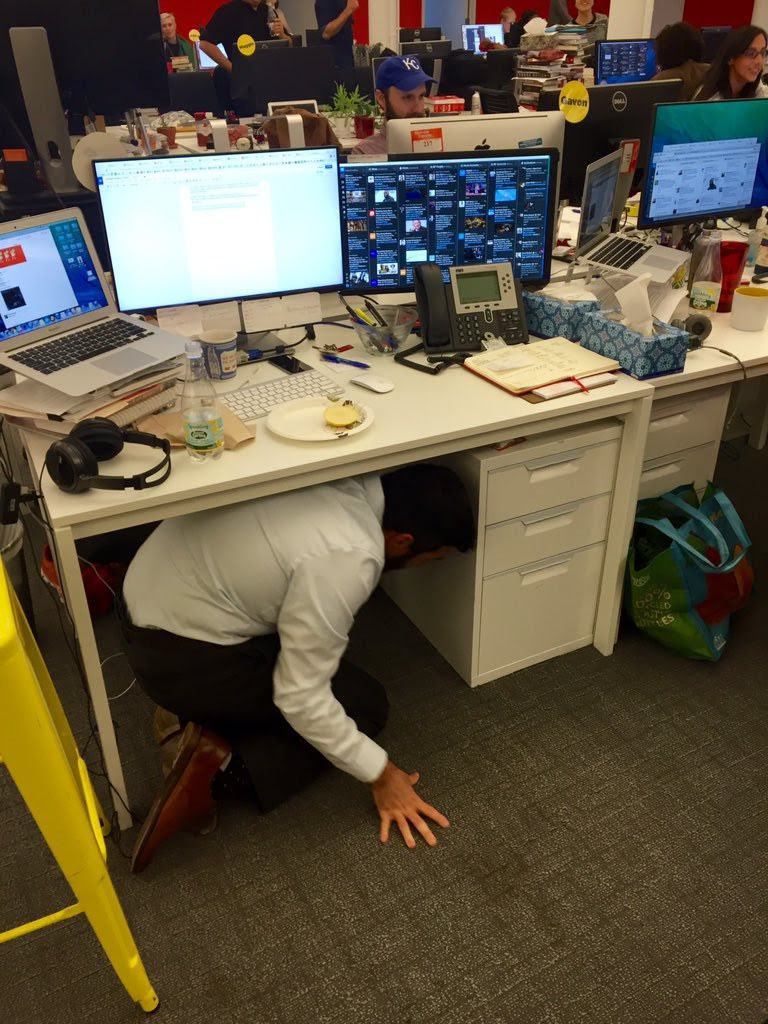
Sara Yasin, former managing editor: BuzzFeed News was the one place where you could just really and truly write any story, and it was celebrated and treated just as important as a huge investigation. The obsessiveness we put into getting stories right — whether it was Blippi or FinCen Files, we weren’t scared of picking up the weird and wonderful corners of the internet. It’s kind of magical to be a large group that’s on the same wavelength in that way. It’s the most fearless I’ve ever been professionally, because I felt like everyone on staff had each other’s backs even when they didn’t agree.
Cody Corrall, audience engagement editor: I was one of a small group of news staffers hired during the pandemic. For the first time in my professional life, I was able to be taken seriously at a national publication while being based in Chicago because of the expansion of remote work (protections which would later be cemented in our union contract). Nobody at BuzzFeed News cared where I went to college or if I worked at a “prestigious” enough job before coming here. There was simply no ego. Expanding access to remote employees just showed how much talent is at our fingertips if we stop honing in on New York and LA as the bastions of “real” journalism: incredible designers, audience editors, and reporters from all over were able to get their foot in the door because of that.
Zia Thompson, audience engagement editor: An internet comment section is a notoriously awful place to be, but every now and again, while I’m trudging through the mud, I’ll see people write comments that fill me with so much pride: “Thank you for bringing attention to this.” “Thanks for saying the quiet part out loud.” “This was so interesting and really made me think.” Reading those things, knowing that even just one person found affirmation, meaning, or understanding in what we were doing made it all worth it. This is one of — if not the only — places where we could communicate, both in reporting and in social copy, how normal people talked. We were serious when we needed to be and fun whenever we could be and it just worked.
The audience team got to call it like it was and never minced words. To be “the smart friend in your pocket” was our objective and I believe we achieved that. It’s just now hitting me that there probably won’t be another place that will let me make a dick joke about Jeff Bezos’s rocket on TikTok, write thirsty copy for a story about hoochie daddy shorts, or come up with clever punny headlines for the homepage whenever I want, and that makes me sad.
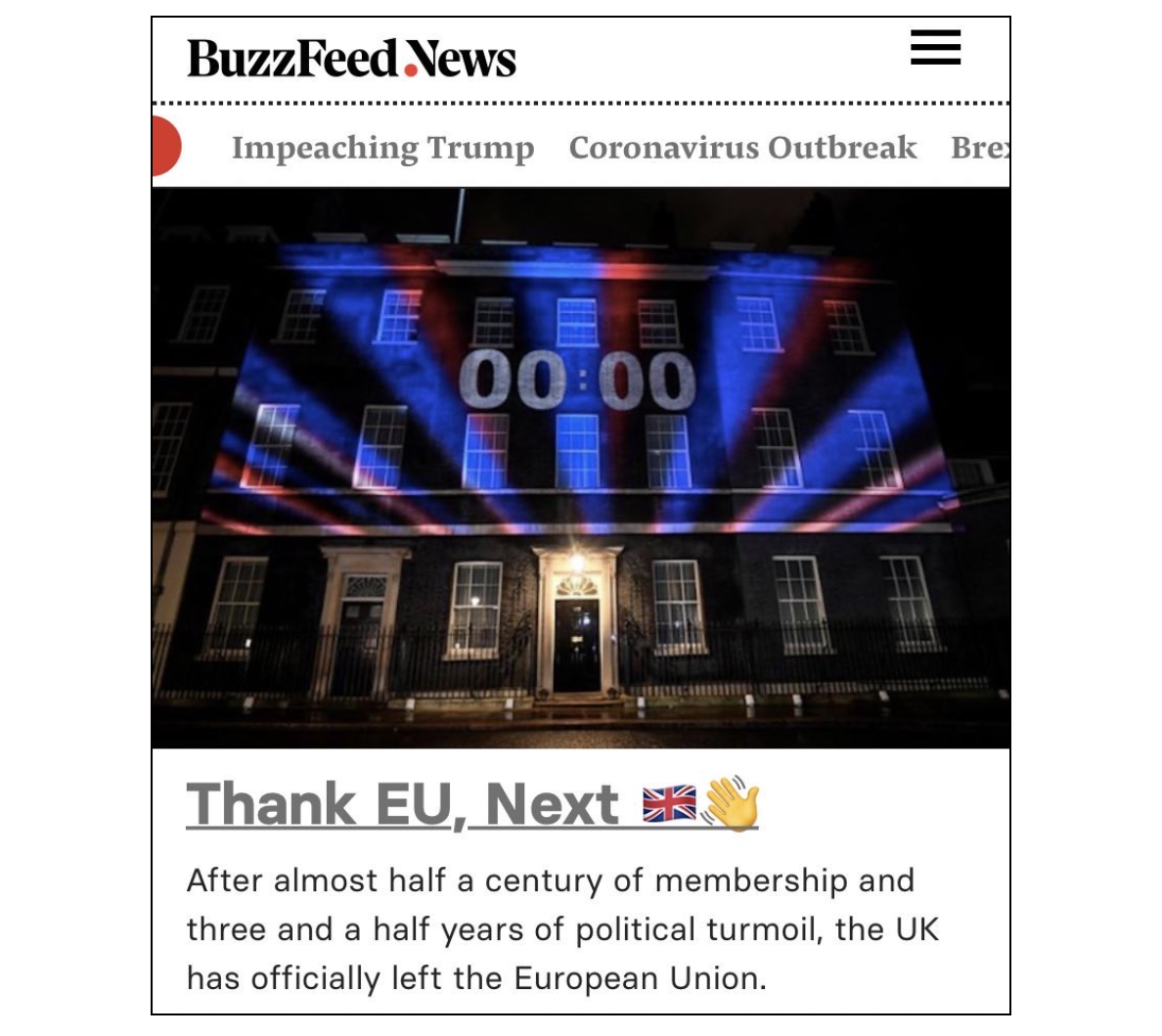
Brandon Wall, director of newsroom strategy and experiments: It’s important to realize how many things in journalism that are now taken for common were pioneered by BuzzFeed News, particularly #TeamNewsApp and News Curation. The way news organizations approached push alerts changed almost overnight with the launch of the BuzzFeed News app and our strategy of sending conversational alerts (that didn’t feel like copy-pastes of headlines! What a concept!) about stories that our readers actually cared about — not what some editor thought was important.
We were breaking down complicated stories into visual, bite-size chunks that’s now pretty common all the way back in 2015. We were building direct relations with our readers (we had a BuzzFeed News App Facebook Group!). And as alumni of these teams moved on to other news organizations, our core ideas and approaches spread. It’s easy to forget just how stuffy and boring receiving the news on the internet was in 2014 and 2015.

There’s one push alert we did in particular that came the day after the January 6 riots. It had been an extremely an extremely long 24 hours, when Trump suddenly tweeted a video that sure seemed like he was finally conceding the 2020 election. As director, I was very confident in my language, but figured I should probably get somebody else to sign off on saying “bullshit election fraud claims”... shareable culpability and all that. I sent the GOAT Tom Namako two options for the wording. Tom gave no pushback, but did have a very classic Tom Flourish Edit that made the push pop all the more. And so that’s how this went out to the world:

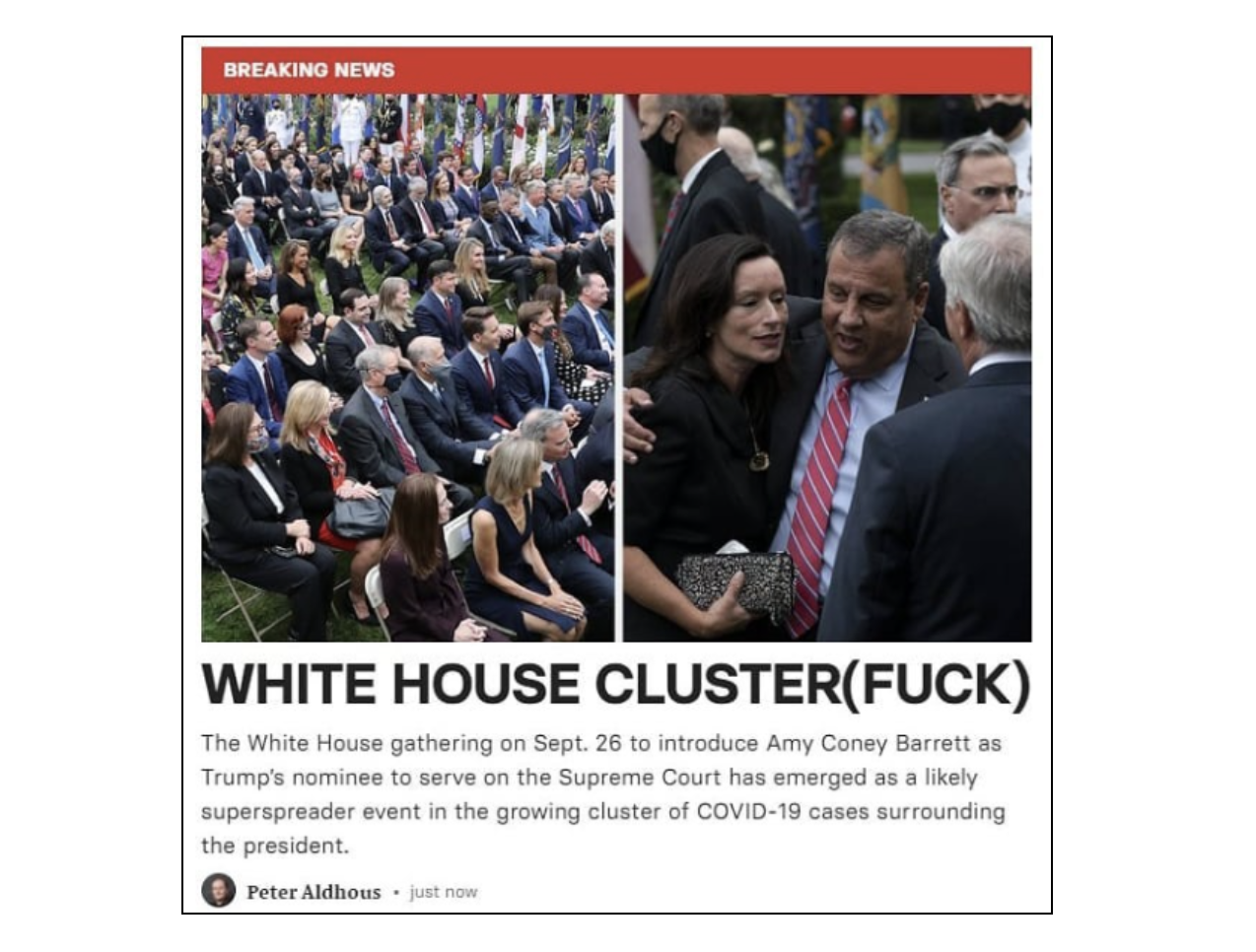
Megha Rajagopalan, former investigative reporter, Pulitzer Prize winner: I just basically met Alison Killing, and we decided we were going to do this project — nobody really ever questioned that it had some potential, even though at the outset it must have sounded nuts, like, I’m going to work with an architect and a programmer to find mass internment camps in China. I don’t know that most newsrooms would have let that go. I was at SXSW with Alison, we told Ben Smith about the project, and he was like, “Sounds really cool.” I think it’s probably a function of the level of trust editors put in reporters at BuzzFeed News, which I think would be harder for early and mid-career reporters to gain elsewhere. And then when Mark Schoofs became editor-in-chief, he immediately took an interest in the project and knew that it was going to be meaningful.
The day before the Pulitzer was announced, a few of us got an email that BuzzFeed had entered us, and I was like, Oh, OK. I still didn’t think we had a chance, I assumed the FinCEN Files, also from BuzzFeed News, would win. The next day we had a team lunch in London where it did not come up. I went home and basically found out when Mark Schoofs called me and I was like “What??” They were announcing it on a livestream, and I wasn’t watching. My husband was actually watching in the other room, so he found out before me.
Anna Betts, reporter: BuzzFeed News was the first-ever newsroom I worked in as a full-time reporter. I was so nervous and had major impostor syndrome as I was going to be working with so many journalists and editors that I had looked up to for so long. As soon as I started in 2022, I was welcomed with open arms by everyone in the newsroom and straight away treated as a part of the BuzzFeed News family. I couldn’t believe the amount of freedom I was given as a new reporter when it came to the stories I got to cover.
For four months, I was given the opportunity to solely focus on an investigative story about the cruise industry that I was writing with the legendary Tom Warren, along with the best editing team: Karolina [Waclawiak], Mary Ann [Georgantopoulos], Mark [Yarm] and Jason [Wells]. Working on this project made me a better reporter and cemented my love for journalism and storytelling. I will forever cherish those months working with the dream team on such an impactful piece and embracing the chaos that came with it.
Pranav Dixit, tech reporter: I joined BuzzFeed News in 2016 as a correspondent on the Tech desk based in India. We never had an India bureau for News, but my boss, Mat Honan, had the foresight to realize that American tech companies weren’t just changing people’s lives in the US but around the world. BuzzFeed’s tech coverage needed to reflect that. We brought BuzzFeed’s unique brand of tech coverage to India, asking tough questions of American tech companies as they raced to hook a billion Indians coming online for the first time to their products.
Scaachi Koul, senior culture writer: I believe in nothing, but I always believed in the work we did. Karolina gave me a kind of latitude I never thought I would get as a writer. She was my editor for more than seven years, and in that time, we did so much weird, cool shit: We profiled Lil Pump and Courtney Stodden and Jhumpa Lahiri and Trisha Paytas. We wrote about Trump with the same seriousness that we wrote about Ned from the Try Guys. We wrote reported mega-features on plastic surgery, QAnon, the weight loss industrial complex, and white supremacy. Then, the next day, we’d write about how Friends sucks. Karolina would text me in the middle of the night about some freakish Netflix softcore (using this term lightly) porn film and the next morning I’d be watching it at 8 a.m. and then we’d write something insane and a literal million people would read it.
I’m devastated about a lot, but high on my list are all the stories I still wanted to do, that we still wanted to do, that we can’t anymore. Karolina only got a few months as editor-in-chief, and I was excited about the future, how we’d break and reshape conversations about culture and politics and the internet. These stories will live elsewhere, I know, but their conceptions and conceits are a testament to this bizarre, sometimes hectic, sometimes languid, always expansive place. The more I think about the work we did, the more this closure is solidified in my own mind as a mistake. But so it goes: We’re all fuzzy little pappi getting blown off a dandelion stem by a strong breeze. We’ll all land somewhere, and we’ll pollinate anew.
Karolina Waclawiak, editor-in-chief: Thinking about how much range this newsroom had will always stop me in my tracks. The talent! The breadth of reporting! There were no limits to what we’d publish each day, even as our budgets were shrinking. Because we had this massive platform, we had the ability to change the conversation online with any given story on any given day. It was really awe-inspiring to watch things go viral and to be the guiding hand for what everyone was talking about that day because millions of people would read the stories we published. I would come up with outlandish ideas and the writers would be game for it. Writers would come up with wild ideas and I trusted them enough to just go with it. Hitting publish on something was both exhilarating and terrifying — this could change everything or we could be run off the internet. I remember waking up from time to time thinking, How is it that I — and we — get to define what’s important in America? It feels like a fever dream. ●
Reported by Katie Notopoulos and Ellie Hall
